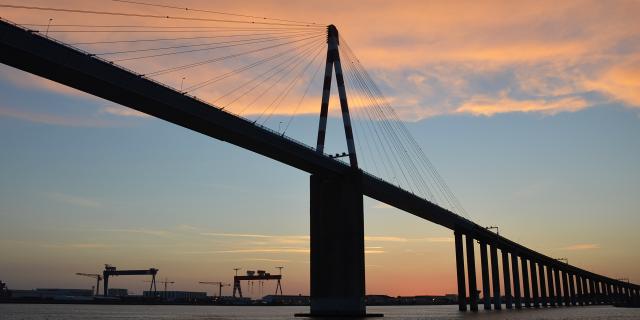
- Destinations
- The 10 destinations
- Brittany Loire Ocean

Saint-Nazaire
While it’s not one of France’s most attractive cities, St-Nazaire makes a fascinating destination for boat and plane enthusiasts as well as fans of World War II history. The beaches along its coastline are some of the best in the Loire-Atlantique department; one was immortalised on film.

An industrial city
Ships of all shapes and sizes.
Saint-Nazaire is best known for its shipbuilding industry, which began in the 19th century. In 1862 the port became the departure and arrival point for France’s first transatlantic crossings to South America thus, Saint-Nazaire became a centre for building ocean liners; the Queen Mary II was built here in 2003. To find out more about this fascinating industry, head to Escal’Atlantic, where you can travel around the world in 90 minutes on board a life-size reconstruction of one of these magnificent ships.
Submerged in history
Escal’Atlantic is housed in the impenetrable German submarine base, which was built during the Occupation and became the French HQ for the German navy, the Kriegsmarine. As a result, Saint-Nazaire became a major target for the Allies who destroyed the shipyards during Operation Chariot in 1942 followed by the rest of the city via a bombing raid in 1943. You can explore a real submarine, L’Espadon, which was used by the French navy from 1960-85; there are audio-guides in English. Guided tours are also available of the shipyards and the port terminals, although English-language tours are only available to groups of 20 or more. Visitors can learn about the history of the city, its port and industries at the Écomusée.
Saint-Nazaire is home to one of Europe’s Airbus factories; it’s here that the main fuselage sections are assembled and tested for all the company’s planes including the new A380 – the world’s largest civilian aircraft. French-speakers can join a guided visit where they might be lucky enough to see La Beluga, the giant cargo plane.
The coast around Saint-Nazaire has some lovely beaches – take the old customs officer’s path, lined with Mediterranean flora, to Les Jaunais. The resort of Saint-Marc-sur-Mer is where Jacques Tati filmed Mr Hulot’s Holiday in 1951.
The Queen Mary II was built here in 2003
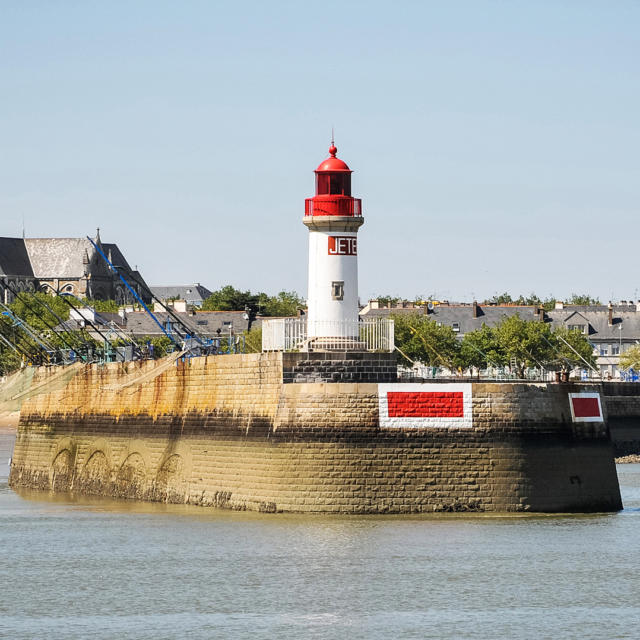
Did you know ?
Of the 611 British soldiers who took part in Operation Chariot, only 224 made it back to Britain.

Information & bookings
Tourist Office Saint-Nazaire
- See the website
Plan your holiday

Getting there
Getting to saint-nazaire.
There are direct flights from Gatwick and Stansted to Nantes-Atlantique Airport, located about 60 km from Saint-Nazaire, with transport from the airport on the TER regional transport network or by bus . By train, Eurostar takes 2 hours and 16 minutes from London to Paris, then there are 13 TGV intercity services each day from Paris-Montparnasse to Saint-Nazaire, taking 2 hours 34 minutes. By car, Saint-Nazaire is 195 km from the ferry port at St Malo, 301 km from Roscoff ferry terminal, 412 km from Bordeaux and 441 km from Paris.
Travelling in and around Saint-Nazaire
It’s very pleasant to stroll through Saint-Nazaire, enjoying the sea front and watching boats and liners sailing out of the port. Saint-Nazaire is also very well served by the Stran bus network. Another way to get around is to use the Vélycéo cycle hire service – classic or electrically-assisted bikes are available to rent by the half-day. The Lila bus network and the TER regional transport network allow you to explore the Loire Ocean area and the rest of Brittany effortlessly.
Discover other cities
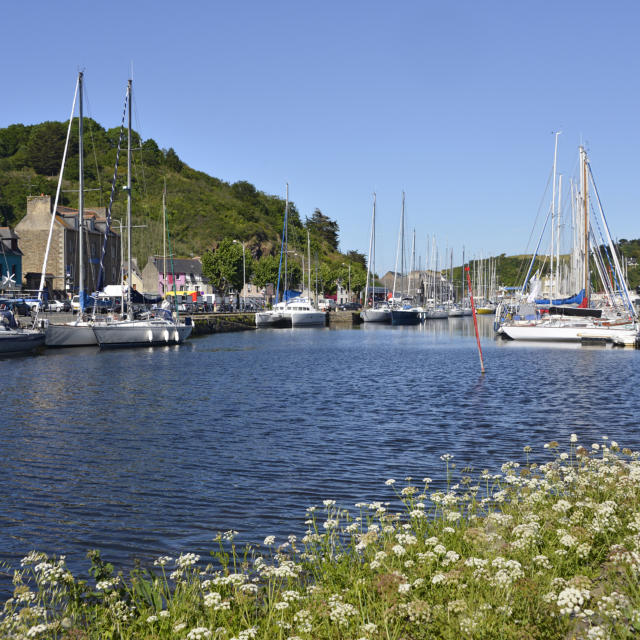
- Make life simpler: add your favourite pages as bookmarks.
- Trade professionals

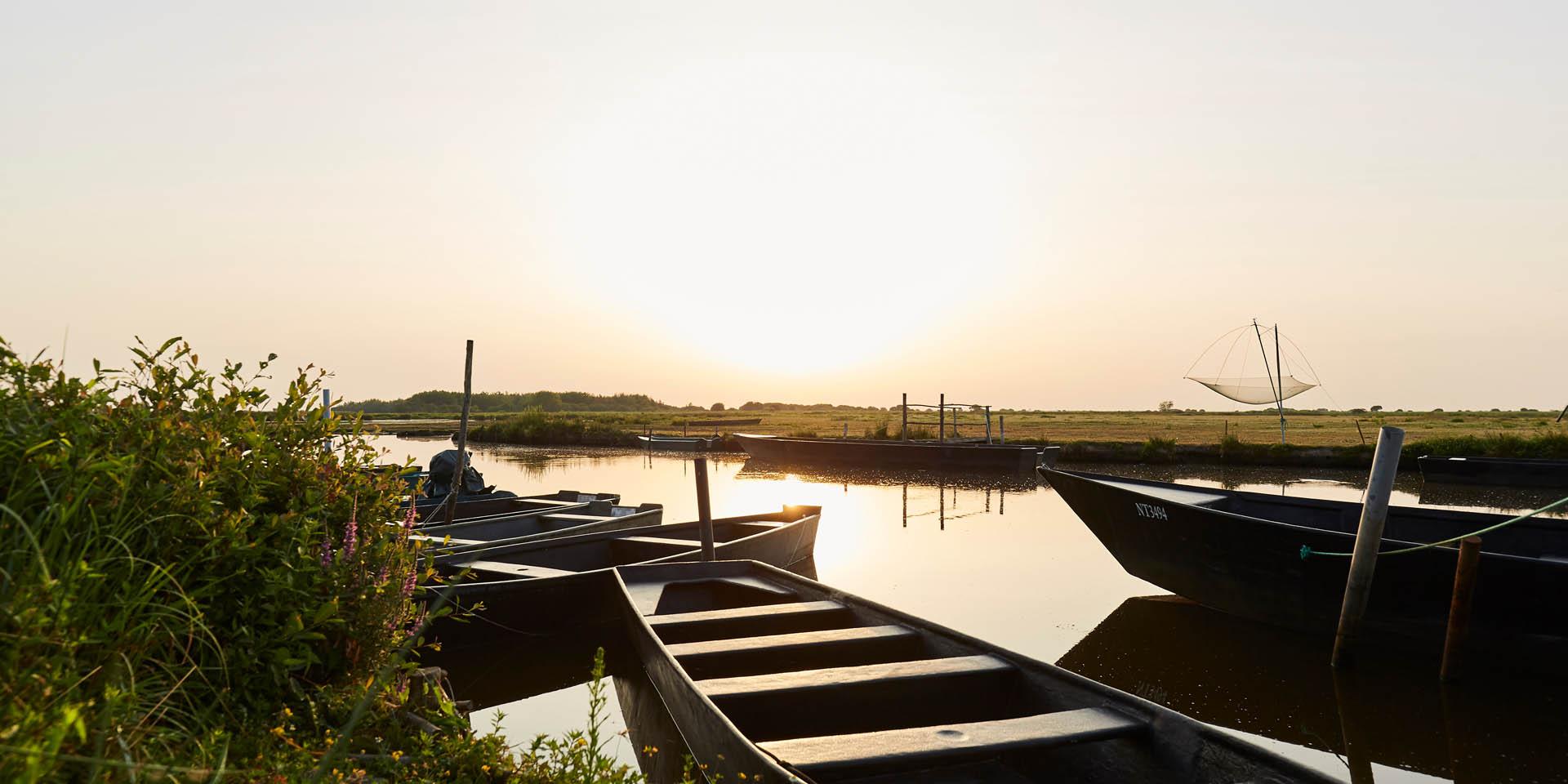
Tout savoir sur L'Office de Tourisme
- Accueil – Saint-Nazaire Renversante
- Préparer votre séjour
- L’Office de Tourisme
L’Office de Tourisme Intercommunal est votre interlocuteur privilégié pour préparer votre séjour à Saint-Nazaire et en Brière. Vous y trouvez toutes les informations sur les manifestations, l’hébergement et la restauration, ainsi que des brochures, plans et documents concernant l’offre touristique de Saint-Nazaire Renversante et de toute sa région. Alors, qu’attendez-vous pour passer nous voir ?!
L'Office de Tourisme vous accueille
L’office de tourisme intercommunal est à votre disposition.
Pour vous renseigner tout au long de l’année et pendant vos vacances, nos conseillers de la destination vous accueillent dans nos deux Offices de Tourisme, à Saint-Nazaire et au cœur du Parc naturel régional de Brière à Saint-André des Eaux .
Renseignement, conseils, documentation, billetterie… l’Office de Tourisme vous facilite l’organisation de votre découverte des incontournables de notre destination à Saint-Nazaire et en Brière.
Vous les retrouverez également sur votre chemin lors de leurs déplacements ponctuels sur les marchés, aux abords des plages et à l’occasion des événements organisés sur le territoire.
Toutes les infos pour passer des vacances de rêve !
Notre équipe d’experts de la destination vous offre des conseils personnalisés et vous dévoile ses coups de cœur. Découvrez les meilleurs restaurants, hébergements et sites de visites !
Repartez avec votre documentation gratuite et à vous les vacances de rêve !
Envie de sortir, de vous amuser, de réserver une activité ?
On s’occupe de tout ! Avec nous, concoctez un programme pour votre séjour et réservez directement vos billets pour de nombreuses activités, parfois même à tarifs préférentiels !
Loisirs, musées, visites… Chacun y trouve son compte !
Venez nous rencontrer

Nous contacter
Office de Tourisme de Saint-Nazaire et Brière :
- Tél : 02 40 22 40 65
- E-mail : [email protected]
Retrouvez l’équipe de l’Office de tourisme de Saint-Nazaire et de la Brière lors de déplacements ponctuels sur les marchés, aux abords des plages et à l’occasion d’événements organisés sur le territoire !

On s'engage pour vous !
Bienvenue .
Laurence, Charline, Diana, Axel et toute l’équipe sont mobilisés pour vous accueillir, vous informer et même vous chouchouter, toute l’année !
Notre Office de tourisme est labellisé Qualité Tourisme : cela veut dire que nous nous engageons durablement pour vous, vacanciers et locaux ! Notre mot d’ordre : faire toujours mieux et aller encore plus loin.
L’Office vient à vous !
En triporteur ou en méhari, sur des stands éphémères… L’équipe de l’Office de tourisme de Saint-Nazaire se déplace sur les marchés, les plages et se rend aux événements phares de la destination.
Le territoire n’a pas de secret pour nous !

Brochures et plans à télécharger
Toute la documentation touristique à portée de clic .
Par respect pour l’environnement, l’Office de Tourisme s’engage à limiter le nombre de tirages de ses éditions. Nous vous encourageons à télécharger nos brochures et nos cartes touristiques qui vous permettent de découvrir d’un seul coup d’œil les multiples atouts de notre destination.

L'Office de Tourisme engagé pour la qualité
L’office de tourisme intercommunal est engagé pour vous accueillir dans les meilleures conditions..
L’Office de Tourisme Intercommunal de Saint-Nazaire Agglomération a obtenu, par décret préfectoral le 6 février 2019, le classement en catégorie I. Cliquez ICI pour voir nos engagements .
L’Office de Tourisme Intercommunal est également engagé dans une démarche qualité, ayant permis l’obtention de la marque Qualité Tourisme™ et dans le cadre de cette période particulière, toute l’équipe a été formée pour vous accueillir dans des conditions optimales.
En Brière, à Saint-André des Eaux, notre Tiny-Office de Tourisme a obtenu le label « Valeurs Parc » pour nos engagements en faveur de la préservation de l’environnement, de la valorisation des ressources naturelles et culturelles propres au Parc naturel régional de Brière et les habitants et acteurs économiques locaux qui le composent. Découvrez tous nos engagements pour la Brière à travers le label Valeur Parcs.

À bicyclette ♪♫♪
L’Office de Tourisme de Saint-Nazaire, ainsi que les sites de visite Escal’Atlantic, le sous-marin Espadon et l’Ecomusée sont labellisés Accueil Vélo , et sont situés sur les véloroutes Vélocéan et La Loire à Vélo .
Découvrez aussi toutes nos idées de balades à vélo !

Toutes les infos utiles pour préparer votre arrivée

Nouveaux arrivants A Saint-Nazaire

Vous déménagez à Saint-Nazaire ou dans l’une des communes de son agglomération ?
L’agglomération de Saint-Nazaire vous accueille et vous renseigne pour organiser au mieux votre installation. Retrouvez toutes les informations pratiques et le dispositif d’accueil sur le site de l’agglomération .
- Séminaires et congrès

Visit Saint-Nazaire
Saint-nazaire, a city by the sea.
Ideally situated both on the banks of the Loire (External link) estuary and the Atlantic Ocean, Saint-Nazaire is quite literally a city by the sea. Its waterfront, 20 beaches, and Nantes Saint-Nazaire Port , the most important harbour on the French Atlantic coast, give it that special seaside feeling.
Highlights in Saint-Nazaire
- Escal’Atlantic, the “Ocean Liner Experience“: inside the former submarine base, visitors will enjoy a spectacular voyage into the world of transatlantic liners. The atmosphere and evocative setting of this unique venue have been enhanced with new dimension. Interactive features, audiovisual displays and “hands-on” devices, as well as nearly 200 original artefacts from liners built in Saint-Nazaire make for a dynamic and unforgettable visitor’s experience. Escal’Atlantic has been awarded the national quality label “Qualité Tourisme” .
- The Espadon submarine: Built in the 1950’s, visitors discover the first French submarine to have dived beneath the Arctic ice field, and experience the living conditions of the 65 crew members who had to do with one single (salt water) shower, and sleeping in turns, as there were not enough bunks.
- The heritage museum Ecomusée: The permanent exhibition recounts the history of Saint-Nazaire, from prehistoric days to the 21st century. Scale models of ships and the harbour site, tell the story of how the harbour was created in the middle of the 19th century, and how it developed over time (quality label “Musée de France”).
- Industrial tourism and fascinating guided tours: be a privileged spectator and watch cruise ships being built in the shipyard STX France , see the huge A380 being assembled in the Airbus factory , and discover the impressive harbour terminals of Nantes Saint-Nazaire Port , linked to 400 ports throughout the world.
- The “Ville-Port“ quarter, which links the city and its harbour, offers spectacular views from the roof of the submarine base over the harbour basin, the estuary, the shipyard, and surprisingly, contemporary art! Works by artists Gilles Clément and Felice Varini use the submarine base and the whole harbour site as a giant “canvas“.
- The neolithic barrow “Tumulus of Dissignac“ (~ 6,000 years old), is one of the most remarkable prehistoric monuments of the region.
- Tintin in Saint-Nazaire : walk in the footsteps of famous comic strip heroes Tintin and Snowy. The story “The seven crystal balls“ brings them to Saint-Nazaire, and you can follow their trail via enlarged pictures taken from the story, which have been put up around the harbour.
Seaside Saint-Nazaire
- 20 beaches dot the coast in Saint-Nazaire, and two of them offer bathing facilities for the disabled . Looking for the most popular beach? The winner is… “Monsieur Hulot’s“ beach , in the Saint-Marc-sur-Mer part of town. It’s the very beach where Jacques Tati shot his famous film, “Monsieur Hulot’s Holidays“ in the early 1950’s.
- The two-hour cruise “Saint-Nazaire by the sea“ is a pleasant way of discovering Saint-Nazaire by boat. The ship sails along the shipyard, underneath the Saint-Nazaire bridge, and then along the beaches.
- The waterfront near the city centre makes for lovely walks. There are still some stately houses from the late 19th century to be seen, as well as the typical fishing cabins on stilts.
- The coastal footpath , the former "Customs officers’ path", runs along the coast for several kilometres, along beaches, cliffs and coves. Enjoy the views over the sea, no matter whether the sky is blue or grey…
- “La Folle Journée“ (January): two days filled to the brim with classical music concerts.
- “Les Escales“ (early August): this festival of world music, which defines itself as a musical dialogue between cultures and continents, takes possession of the harbour site for two nights of music and fun.
- “Consonances“ (September): the chamber music festival of Saint-Nazaire, brings a whole week of outstanding music and internationally renowned musicians to the city.
- Street shows from (April to September) in the city centre and Saint-Marc-sur-mer.
- Free concerts in bars and pubs (July and August).
- Huge picnic on the beach in early June
- Sailing regattas : the “Record SNSM“ in June is part of the agenda every year; as well as a promising new regatta between Saint-Nazaire and the Mexican province of Yucatan, the “Solidaire du Chocolat“, which has taken place twice already.
Savours and flavours
Even if there is no particular culinary speciality which is linked to the name of Saint-Nazaire, the sea being so close provides loads of deliciously fresh seafood . Take a stroll in the central market on Tuesday, Friday or Sunday morning, and you’ll find the most mouthwatering treats!
Prepare your stay
The Tourist Information Office , inside the former submarine base (follow the “Ville-Port“ signs when you arrive in Saint-Nazaire), has all the information and insider tips you need about hotels, restaurants, what to do and see.
Very practical before coming to Saint-Nazaire: check a free service on the website which gives you access to hotel room availability, and allows for direct booking .
Paris 437 km – Angers: 144 km (Motorway A11) Nantes: 64 km – La Baule: 15 km Rennes: 125 km - Vannes: 87 km Les Sables d'Olonne: 168 km
Saint-Nazaire has a TGV (high-speed train) station, and is reached in less than three hours from Paris.
Nantes Atlantique International Airport is less than an hour’s drive from Saint-Nazaire.
Ferry service
Three times a week, a car ferry runs between Saint-Nazaire and Gijon, on the Northern coast of Spain.
Saint-Nazaire Tourisme & Patrimoine / Visit Saint-Nazaire Office de Tourisme Base sous-marine, Boulevard de la Légion d’Honneur, Ville-Port 44600 Saint-Nazaire Phone: 00 33 240 224 065
(External link) Information about the tourist sites : phone 00 33 228 540 640
- Availability of tourist accomodation (External link)
- Contact (External link)
Saint-Nazaire
Romantic tales around the Châteaux
5 little-known Loire Valley châteaux worth a visit
An autumn getaway in Sologne between nature and well-being
Take a trip amongst the gorgeous castles of the Loire Valley
Family travel
5 good reasons to cycle together in the Loire Valley
Living cultural heritage
The Royal Abbey of Fontevrau, an "ideal city" for modern times.
Chaumont-sur-Loire International Garden Festival
Until November 3
Calvi on the Rocks in Corsica
Until June 30
Saint-Nazaire

- 1 Understand
- 2.2 By train
- 2.3 By plane
- 2.4 By bike
- 3 Get around
- 5.3 Beaches
Saint-Nazaire is a port town of 153,000 people (2017) at the mouth of the Loire, near Nantes in western France .
Understand [ edit ]
The town has a fine port and shipbuilding has long been an important industry. In the 20th century, aircraft manufacture became important; Airbus have a large factory in the town.
During World War II , the drydock at Saint-Nazaire was the only one on the Atlantic coast of German-held France that could repair large vessels such as battleships. British raiders put it out of commission in 1942 by ramming it with a destroyer (an old ship that had been built for the US Navy during World War I ) packed with explosives; it was not repaired until 1947.
- Tourist information . ( updated Dec 2020 )
Get in [ edit ]
By car [ edit ].
The Route nationale N165/N161 (E60 route) connects Saint-Nazaire to Nantes and Rennes via the Pont de Saint-Nazaire, which crosses the Loire. Paris is then accessed via the A10/A11 in Nantes. Valves, Lorient, Quimper and Brest are accessed via the N165.
By train [ edit ]
Saint-Nazaire railway station is served by the TGV and regional trains and buses of the TER Pays de la Loire. TGV (high speed train) connection from Paris, Lyon, Marseille, Lille, and Strasbourg, with trains from Paris via the LGV Atlantique taking just over 2 hours. TER Pays de la Loire provides service from Nantes, Angers, Le Mans, La Roche sur Yon, and other regional cities and towns.
By plane [ edit ]
Saint-Nazaire airport is 5 km (3 mi) south-east of Saint-Nazaire, in the commune of Montoir-de-Bretagne.
International travel is via Nantes Atlantique Airport , the biggest airport in western France, linking with several French and European cities as well as Montreal in Canada (seasonally) and some cities in North Africa.
By bike [ edit ]
- EuroVelo 6 : Saint-Nazaire is one end of the EuroVelo 6 or EV6, also known as the “Eurovéloroute des Ranches”, a EuroVelo-type cycle route that connects Saint-Nazaire to Constanţa in Romania. It is 3,653 km long, crossing Europe from the Atlantic Ocean to the Black Sea, passing through ten countries. It follows the route of three of the largest European rivers: the Loire, the Rhine and the Danube.
- Vélocéan : Vélocéan is a cycle route on the Atlantic coast in the Loire-Atlantique department, and therefore serving Saint-Nazaire.
Get around [ edit ]
A free electric shuttle connects the theater car park (free parking) to the city center in a few minutes, passing through the Tourist Office and the city's flagship tourist facility "Escal'Atlantic".
Saint-Nazaire and the other municipalities of its agglomeration are served by a fairly dense public transport network, managed by STRAN. In addition to getting around town, the buses can, for example, also help you cross the Grande Brière (Lines 2, 3 & 4, towards Saint-André-des-Eaux , Saint-Joachim , Saint-Malo-de- Guersac , or Line 9 towards Besné), then drop you off near the "Most beautiful beach in Europe" La Baule and Pouliguen (Line 6 & 7, towards Pornichet). For a minimum price of €1.2 per trip (transfers are prohibited for single tickets). The "FREEDOM TICKET" ticket, valid for one day on the entire STRAN and TY'BUS network. Price: €3.5
The Hélyce bus route connects Saint-Marc sur Mer to Saint-Nazaire station in less than 20 min.
See [ edit ]

- City-port zone : the submarine base, the port, the forms of construction of the liners. Very nice point of view from the roof of the submarine base.
- The wild coast : Follow the customs path that runs along the coast from the beaches of Saint-Nazaire to the beaches of Saint-Marc-Sur-Mer and beyond to Pornichet.
- Saint-Marc-sur-Mer , with its pleasant beach immortalized by Jacques Tati in his film Les vacances de Monsieur Hulot (1951-53).
- Airbus Saint-Nazaire , Saint-Nazaire Tourisme & Patrimoine 3 boulevard de la Légion d’Honneur France , ☏ +33 228 540 640 , [email protected] . Generally on Wednesday and Friday; extra visits during French school holidays . A must-see for any aviation enthusiast, tours meet at the submarine base and you board a bus to be taken to the Airbus plant. Inside you'll see various stages of aircraft manufacture and different processes will be explained. Tours available in English. Free up to 4 years; €7 age 4-14; €14 full price . ( updated Jan 2017 )

- Le Grand Café , Place des Quatre z'horloges ( by bus: Quatre z'horloges stop on line U2, or Rue de la Paix stop on Hélyce line ), ☏ +33 2 44 73 44 00 . Sep-Jun: Tu-Su 14:00-19:00, Jul-Aug: Tu-Su 11:00-19:00 . A contemporary art center, housed in a 19th-century building. ( updated Dec 2020 )
- The Espadon submarine , Avenue de la Forme-Ecluse , ☏ +33 2 28 54 06 40 . ( updated Dec 2020 )
- Escal'Atlantic , Boulevard de la Légion-d'Honneur , ☏ +33 2 28 54 06 40 . Discover the fascinating history of transatlantic liners though exhibits, a “life on board” atmosphere, and multimedia devices. In English, French, German and Spanish. Three levels, 134 stairs. ( updated Dec 2020 )
- The Avenue de Saint-Hubert ecomuseum , ☏ +33 2 28 54 06 40 . the history of a city, a port and its industries. Explanatory panels in French, a tour guide is available at reception for English, German and Spanish tours. ( updated Dec 2020 )
Do [ edit ]
- Boat trips ply the river between Saint-Nazaire and Nantes. They sail May-Oct several days a week, daily in August, taking 2 hr 30 min each way. The riverbank is dotted with wacky artworks. You can return on the train, which you'll have to do if you take an afternoon boat.
Sports [ edit ]
The city of Saint-Nazaire manages many sports facilities: swimming pools and climbing walls, nautical bases (sailing, canoeing, kayaking, rowing) and fitness trails, stadiums, gymnasiums.
- Bowling de Saint Nazaire Allée de la mer d'Iroise - Oceanis Zone
- Le Sabot d'or 79 [dead link] , route du Vivier l'Immaculée, +33 2 40 66 08 00
- Landes de Cuneix pony club Route de Cuneix, +33 2 40 66 26 46
Events [ edit ]
- Les Escales [dead link] first weekend in August. World Music Festival.
Beaches [ edit ]
The coast of Saint-Nazaire has more than 20 beaches from the city centre to the limits of Pornichet. They offer very varied spaces. They are almost all accessible by the U3 bus line.
From Petit Maroc (Le port) to Pointe à Villès-Martin, three sandy, urban beaches.
- Petit Traict beach, which is very close to the outer harbor jetty, has a children's play area
- the Grand Traict beach, very sensitive to tides
- the beach of Villès-Martin, more suitable for swimming, supervised in summer, accessible to disabled people, volleyball courts.
From Villès-Martin to Pointe de l'Eve: beaches in the form of rather well sheltered coves: Kerlédé beach, Kerloupiot beach, Belle Fontaine beach, Lion Rock beach, Bonne Anse beach, Porcé beach, Trébezy beach, Virechat beach, Port Charlotte Beach, Fort de L'Ève beach (which has a large campsite).
From Pointe de l'Ève to Pointe de la Lande (limit between Saint-Nazaire and Pornichet), the coast measures a little more than 3 km. These are rocky cliffs with many beaches, first oriented to the south-east:
- the beach of Courance (supervised in summer) known for the practice of bodyboard and skimboard
- Saint-Marc beach known as Monsieur Hulot: supervised in summer, accessible to disabled people.
- Saint-Eugène beach
- Grand Traict beach, renowned among surf enthusiasts for its spots
- Géorama beach and manor
- the Petite Vallée beach, partly naturist.
The tip of Chemoulin between the estuary of the Loire and the Atlantic Ocean, carries the fort of Chemoulin, occupied by the French Navy which manages the Chemoulin semaphore there and ensures the control of maritime traffic at the entrance of the estuary; the fort also houses the CROSS.
Beyond Chemoulin, the coast faces south-west:
- the beach of the Jaunais cove, sometimes called the Chemoulin cove, well protected from the wind by high cliffs, is a naturist beach;
- the Jaunais beach (supervised in summer) is the last beach in Saint-Marc, on the edge of the town of Pornichet.
These last two beaches share a large free car park and a reception area for camper vans.
Buy [ edit ]
Eat [ edit ], drink [ edit ], sleep [ edit ], connect [ edit ], cope [ edit ].
- Centre Hospitalier , hospital, emergencies. Boulevard Georges-Charpak, ☏ +33 2 40 90 60 00
Go next [ edit ]
- Has custom banner
- Has map markers
- See listing with no coordinates
- Articles with dead external links
- Pays de la Loire
- All destination articles
- Outline cities
- Outline articles
- City articles
- Has Geo parameter
Navigation menu

- Become a Member
10 Reasons to Visit Saint-Nazaire in South Brittany

Saint-Nazaire is a popular seaside town with international connections from the transatlantic ocean liners and ships that set off from its shores to the artists responsible for the incredible art installations, sculptures, and murals that decorate the city. With 15km of spectacular coastline, relaxing sandy beaches, and gorgeous nature reserves, “Little Breton California” is the ideal place to decompress. Here are our top ten reasons to explore the beaches, parks, hikes, and ships of the town – there’s even a submarine to discover.
1. Saint-Nazaire’s beautiful seafront: the perfect place to relax
Sit on one of the many seafront terraces at Place du Commando and sip a lemonade (or something stronger) while watching the tide come in or head to one of the new cafés that come alive once the sun sets. Pathways have been redesigned so pedestrians and cyclists can move about easily. The play area made of driftwood and rope near the Harbour Master’s Office is perfect for children.
If you want to learn more about the pêcheries , the fishing huts that hang over the Loire Estuary, head to the port of Trébézy or Sautron to get a better look. At Sautron , you can even rent a fishing hut if you want to try your hand at fishing or just relax in the peaceful surroundings of the Loire estuary, far away from your office and the demands of work.

Welcome to Saint-Nazaire, the ideal destination to relax by the sea © Arnaud Dréan
2. 20 stunning beaches and coves
Several kilometres of beautiful coastline reveal 20 lovely beaches and coves . The coves around Port Charlotte and Saint-Eugène provide unparalleled peace for those looking to swim or read with no distractions (other than outstanding natural beauty). Head to Le Skate Park water sports centre if you’re looking for an active time or if you have small children, the central beach has beach games made of driftwood to enjoy. There are two designated Handiplage, six with lifeguards in summer, and one that has starred in a famous French film, Les Vacances de Monsieur Hulot . Plus, three of Saint-Nazaire’s beaches have Blue Flag status.
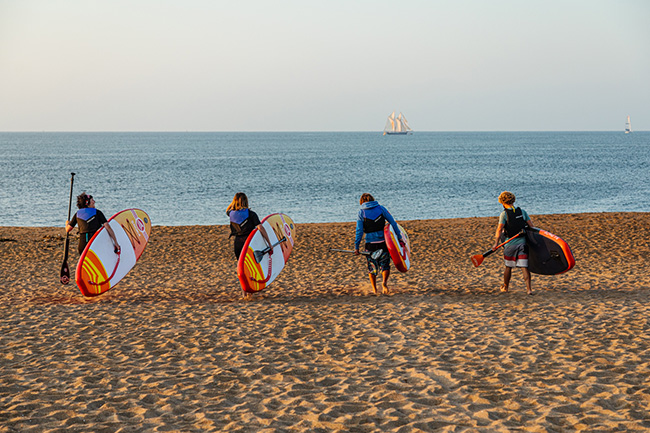
Try some windsurfing on Plage Saint-Nazaire © Farid Makhlouf
3. La Havane district
The La Havane district transports you back to the 1900s. Stroll along the seafront and enjoy the sight of beautiful, coloured houses. The names of the streets – “Havane”, “Vera Cruz”, “Santander” – remind visitors of the many destinations of the transatlantic ships built in Saint-Nazaire.
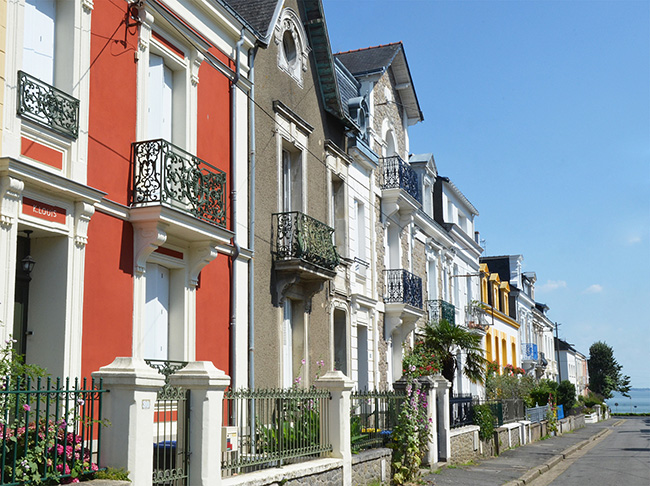
Saint-Nazaire Quartier Havane © A.Klose
4. A town full of art
Stunning street art and murals can be found on the walls across Saint-Nazaire, including a six-storey-high abstract composition by American Ellen Rutt and enigmatic figures painted by Chilean artists Inti and La Robot de Madera in the Petit Maroc Quarter. You can also find sculptures and art installations throughout the seaside town. Saint-Nazaire Tourist Office has a free guide to help you find them all – “Parcours à Saint-Nazaire – l’Art en Ville”! The guide also highlights the unique open-air contemporary art collection, Estuaire , with 34 works to see along 60km of estuary.

At the junction of Rue Henri Gautier and Rue des Frères Pereire, you can find this painting of an Aborigine boy done by Australian Matt Adnate © Arnaud Glize
5. Les Escales Festival
On the last weekend of July, Saint-Nazaire hosts an incredible festival featuring both new and established artists across diverse genres: pop, rock, soul, world and electro. The festival supports various social causes, offering a platform for young designers, promoting local food and having stalls for charitable organisations on-site.
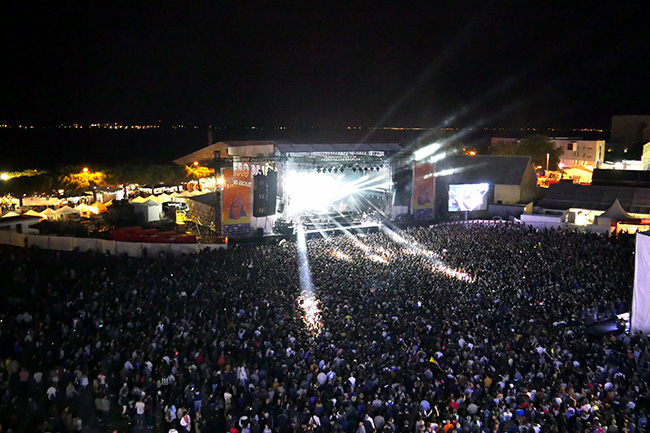
Dance the night away © Hélène Defoy
6. The Customs Officers’ Path
Whether you’re looking for an intense hike or gentle stroll, explore Brittany’s longest waterfront pedestrian path , over 1,240 miles from Mont-Saint-Michel to the Saint-Nazaire Bridge. The GR®34 coastal path stretches 145km and can be covered in five days but there are many shorter walks to enjoy for non-hikers near Saint-Nazaire with its magnificent wild coastline that stretches for 15 km with gorgeous beaches and coves!
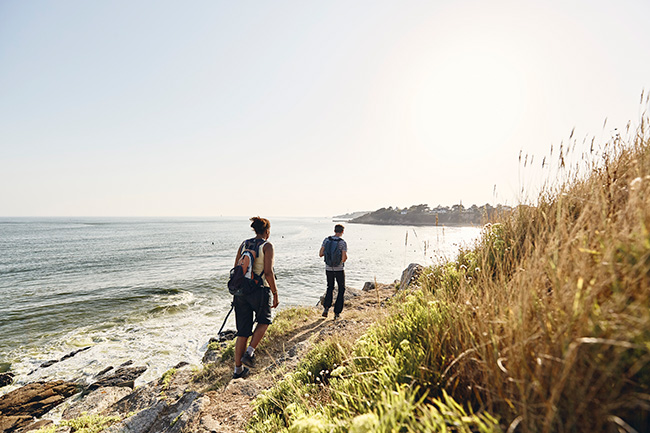
Walk along the sentier douaniers coastal path © Alexandre Lamoureux
7. Explore Escal’Atlantic
Enter the world of legendary ocean liners , learning about the history of transatlantic vessels via interactive devices and games. Look at over 200 artefacts from legendary cruise ships including a chandelier from France (1962) and silverware from Normandie (1935).

Explore the world of ocean liners at Escal’Atlantic © Farid Makhlouf
8. Visit the submarine Espadon
Named after swordfish, the Espadon was the first French submarine to sail beyond the Arctic Circle and dive under the ice fields in the 1960s. Experience life underwater in this steel giant complete with sound effects as you head aboard the only floating submarine in France that civilians can visit. Two English audio guides are available – one for adults (Marc the reporter) and one for children over 7 years old (Jean le Bidou)!

Head underwater in French submarine Espadon © Maelwenn Leduc
9. Visit Saint-Nazaire’s shipyard “Chantiers de l’Atlantique”
Every time a ship leaves the shipyard, an amazing open-air show is held in the Loire Estuary, delighting both locals and visitors. Two-hour guided tours of the shipyard are available in eight languages, including English. Head to the heart of the shipyard to learn all about the incredible ships that have been built at Saint-Nazaire: France, Queen Mary 2, Harmony of the Seas… Discover the secrets of the construction process that keep Harmony of the Seas, the world’s longest cruise ship, and Symphony of the Seas, its sister ship, the world’s largest cruise ship, afloat. Enough to send shivers down your spine!
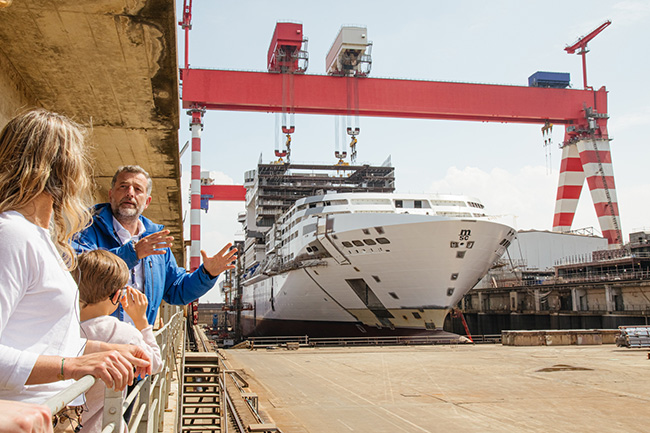
Learn all about Saint-Nazaire’s shipyard © Farid Makhlouf
10. Near Saint-Nazaire, wander around Briere Regional Natural Park
Since 1970, Saint-Nazaire has been one of the 21 towns and villages that make up the Brière Regional Natural Park . As one of the largest wetlands in France and encompassing France’s second largest marshland, there are tons of opportunities to decompress and get away from the hustle and bustle to enjoy exceptional flora and fauna – from Rozé port to Kerhinet village in Saint-Lyphard.
Head out on the water for a boat ride or take a stroll on dry land simply enjoying the sight of the Loire river. The Pierre Constant Regional Nature Reserve in Saint-Malo-de-Guersac is the perfect place for ornithologists, depending on the season, you can see herons and Eurasian spoonbills, bluethroats, wagtails, and swamp sparrows as well as, of course, ducks and geese.
You can also discover the wonderful world of arts and crafts and gastronomic specialities. Brière is known for its thatched houses – you can find over 3,000 in the area. We recommend trying some langouille, a sausage made with pork tongue that works brilliantly in picnics and aperitifs, or escargots cooked in various ways. Local woodworkers also craft using an unusual wood called ‘ le morta’, fossilised oak that is hard and dark, which is used to make knives, sculptures, and jewellery.

Enjoy a trip on the water at Brière Regional Nature Park © Farid Makhlouf
Find out more: https://www.saint-nazaire-tourisme.uk/

Lead photo credit : Plage Saint-Nazaire © Farid Makhlouf
Share to: Facebook Twitter LinkedIn Email
More in bird-spotting , French coast , hikes , music festivals , nature , open-air show , Saint-Nazaire , seaside
Related Articles

Celebrate Impressionism at Saint-Germain Boucles de Seine

Five Must-See Sites Around Dole in the Jura
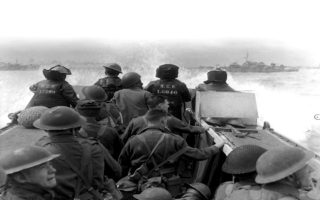
10 Reasons to Visit Juno Beach
By france today editors, leave a reply.
Your email address will not be published. Required fields are marked *
Important Cookie Information
We collect information from our users – this is for administration and contact purposes in connection with contributions you may wish to make to the site or your use of certain site features such as newsletter subscriptions and property enquiries.
Things to Do in Saint-Nazaire, France - Saint-Nazaire Attractions
Things to do in saint-nazaire, tours near saint-nazaire.

Escape game in Guérande

One hour quad ride between Nantes and La Baule

Jet-ski session near Nantes

4x4 crossing in a Private Estate in Pays de Loire

Towed buoy session in Loire Atlantique


Nantes Private Walking Tour With A Professional Guide

Discover Nantes while playing! Escape game - The alchemist

4 DAYS 3 NIGHTS - Wine & History Tours Brittany (Western France)

Outdoor escape game | Vikings - The Relic of Odin

Outdoor escape game | Jules Verne - The extraordinary challenge
Top attractions in saint-nazaire.
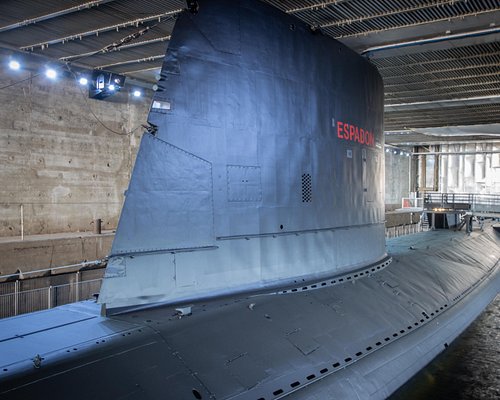
Other Top Attractions around Saint-Nazaire

What travelers are saying
- Sous-Marin l'Espadon
- Escal'Atlantic
- Pont de Saint-Nazaire
- Front de Mer
- Base Sous-Marine de Saint-Nazaire
- Jardin des Plantes
- Plage De Monsieur Hulot
- Plage Les Jaunais
- Naturist Beach Les Jaunais
- Mini golf Saint Nazaire
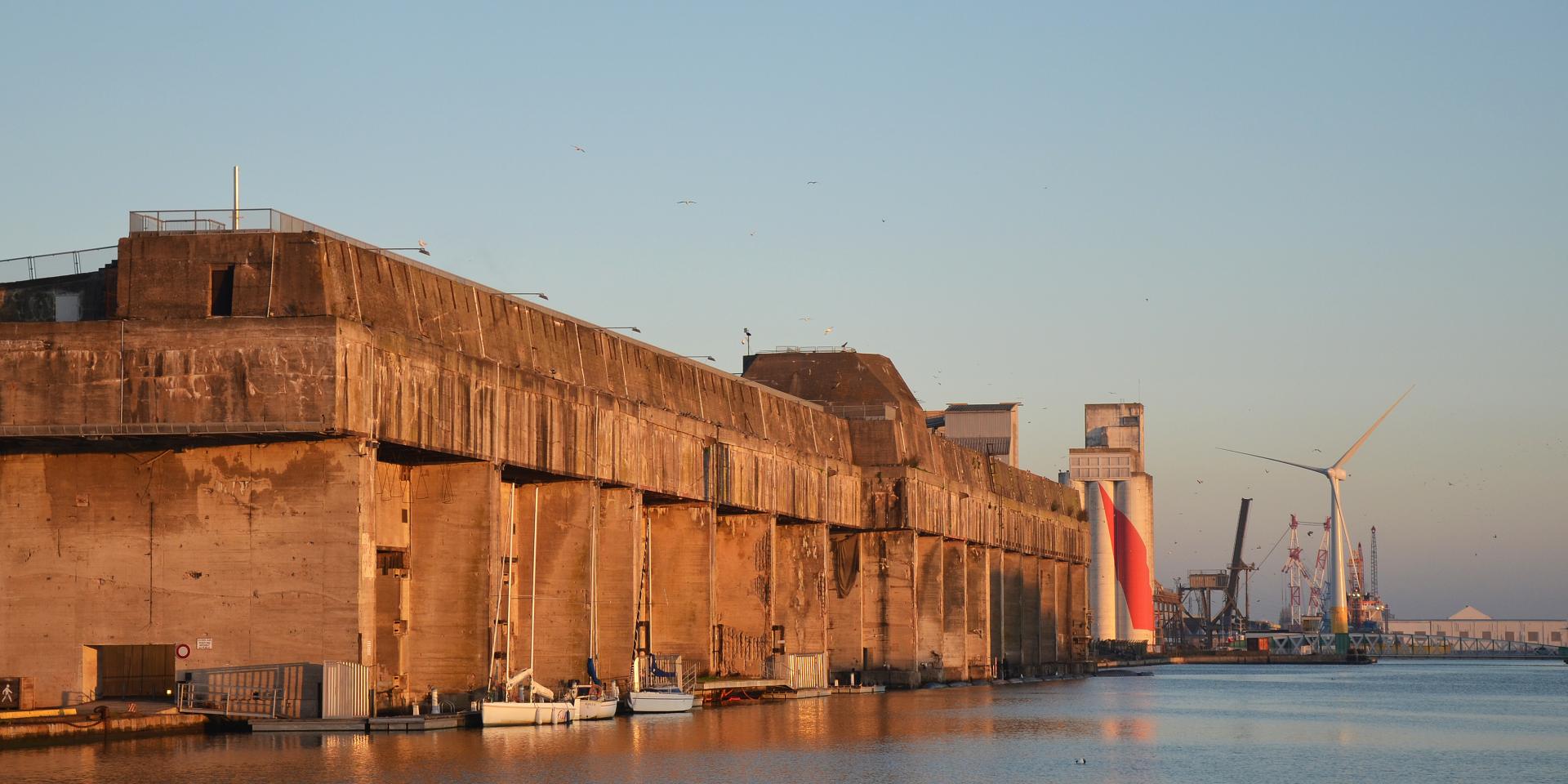
The submarine base of Saint-Nazaire An iconic part of the town
- Homepage – Stunning Saint-Nazaire
- Discover The Port
- The submarine base of Saint-Nazaire
The former submarine base, built by the Germans in WW2, has become an integral part of our landscape. After extensive redevelopment, the base is now a unique cultural and tourism site. Explore its depths then climb to the roof to see your surroundings from a fresh perspective!
The history of the submarine base From the 20th to the 21st Century
An outstanding building, constructed during world war two.
Saint-Nazaire’s submarine base is one of five bases that the Nazis constructed along the Atlantic front during World War Two. This 301m-long strategic base was built in just 16 months in 1941-42, using nearly 500,000m3 of concrete. With a roof up to 9.6m thick, it housed the fearsome U-Boats plus hundreds of men, their offices and workshops until May 1945. The submarine base was built on the site of the original transatlantic port, from where ships used to sail towards America.

Nowadays, the submarine base is an unusual tourist site and cultural centre
Stroll through the narrow walkways, play with perspective, track the light and the water. Above all, be sure to head up to the rooftop and enjoy the incredible views over the town, the port and the estuary. Over the last twenty years, thanks to large-scale works, this submarine base has become an integral part of our landscape. Saint-Nazaire has come back to its original port, turning it into a tourist attraction and cultural centre. As a result, you can come here to visit Escal’Atlantic – a museum dedicated to legendary ocean liners – you can listen to concerts at the VIP , or even enjoy a contemporary-art exhibition in LiFE . The submarine pens are also home to the Tourist Office .
Good to know : experience the outstanding history of the submarine base with a guided tour or a sensory course in French.
Discover the submarine base
Vast. Mysterious. Unmissable. The massive submarine base, built as a defensive fortress by the German army during World War II, still dominates the harbour site today. Come along and discover this extraordinary place, steeped in history and reinvented.

An unusual tourist site and cultural centre
Nowadays, the submarine base is an unusual tourist site and cultural centre: the Escal’Atlantic visitor centre (showcasing legendary cruise liners), LiFE (a space for creativity and exhibitions), VIP (music venue)… The submarine pens are also home to the Tourist Office.
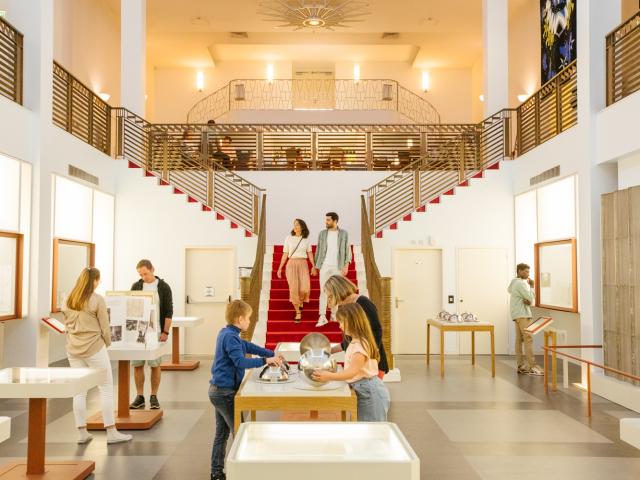
Find out more about Saint-Nazaire’s heritage
The town of Saint-Nazaire was recently awarded the prestigious title ‘Town of Art and History’, a title highlighting the unique history and heritage of the city. If you’d like to learn more about the little-known and often-misunderstood heritage sites, here are a few suggestions.

- Seminars and congresses


Art, travel and culture blog
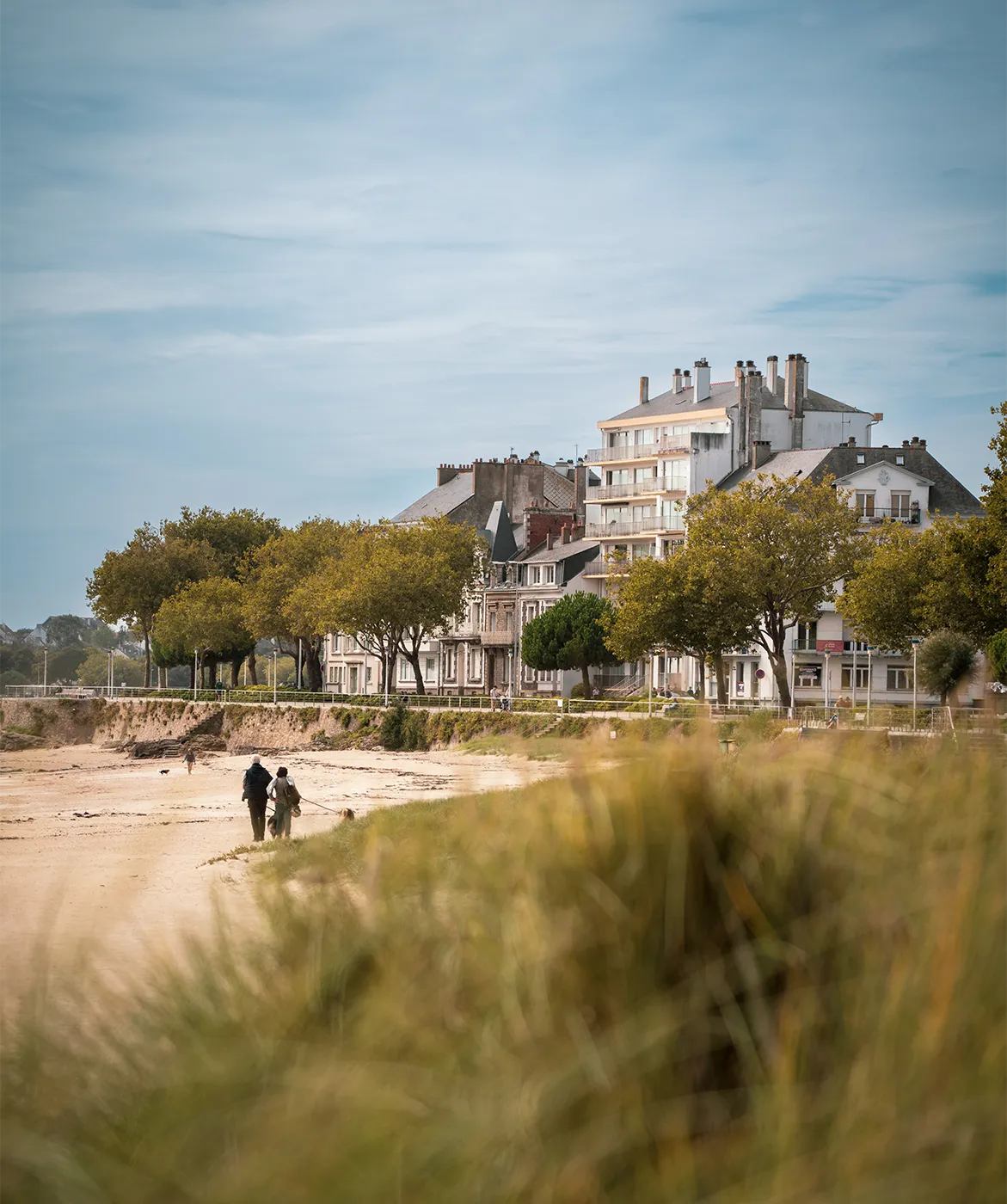
- Travel to france
Discover Saint-Nazaire: 10 must-sees

Why not spend a weekend on the French Atlantic coast? Discover the town of Saint-Nazaire, a destination full of surprises!
Known for its industrial life, Saint-Nazaire is also a city open to art, nature and gastronomy. With its beautiful beaches, fascinating cultural sites and rich industrial heritage, Saint-Nazaire is now a pleasant destination for a weekend getaway or more if you feel like it!
What to do in Saint-Nazaire? What are the must-see sights and the best places to spend a good time? In this travel guide, you’ll find all the tips and advice you need to prepare your stay.
This travel guide is produced in collaboration with Saint-Nazaire Tourisme. However, I reserve the right to make my own comments, so the opinions and suggestions for activities in this article are entirely sincere.
Saint-Nazaire in short
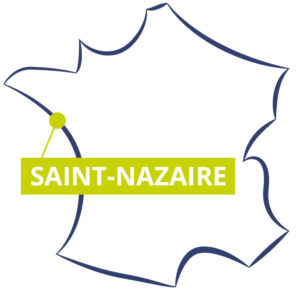
- When should you go? Summer is the best time to go for a swim or to enjoy the beaches, but you can also enjoy the region in spring and autumn, when the weather is mild and there are far fewer tourists than in July and August!
- Who’s it for? Everyone: solo, as a couple, with friends or as a family. There are plenty of activities to suit all ages (see the rest of this article).
- How to get to Saint-Nazaire? Saint-Nazaire is located on the Atlantic coast of France. It’s very easy to get there by train: the journey from Paris takes just 3 hours, with direct TGV services!
- How much does it cost? A weekend in Saint-Nazaire won’t break the bank! If you plan ahead, you can find return train tickets from Paris for less than €100. Some accommodation is very reasonably priced (€60 for two, see the rest of this article) and many activities can be done free of charge. When it comes to food, you can cut the bill by picnicking by the beach, but you’ll also find plenty of brasseries and fast food outlets at reasonable prices.
Understanding the history of Saint-Nazaire
The town of Saint-Nazaire has witnessed many key events over the centuries. Initially, Saint-Nazaire was a small seafaring village, but its importance grew considerably during the industrial revolution.
It was in the 19th century that a key event occurred: as the port of Nantes, sunken in the estuary, could no longer accommodate the increasingly large ships, it was decided to establish an outer harbour at Saint-Nazaire, which would profoundly develop the town.
In the second half of the century , maritime trade between countries became increasingly important. The aeroplane did not yet exist, and transatlantic lines enabled soldiers, diplomats and ordinary travellers to cross the ocean. One of these lines linked Saint-Nazaire to Central America, making the town a particularly important transport hub. In this context, Saint-Nazaire developed a shipbuilding industry, with the creation of the “Chantiers de l’Atlantique”, which played a crucial role in the construction of famous liners, including the famous “France”, “Normandie” and, more recently, the “Queen Mary 2”.
During the First World War , the town was the port of debarkation for the first American contingents: almost 200,000 “Sammies” arrived in Saint-Nazaire between 1917 and 1918, and the town lived on American time for those two years.
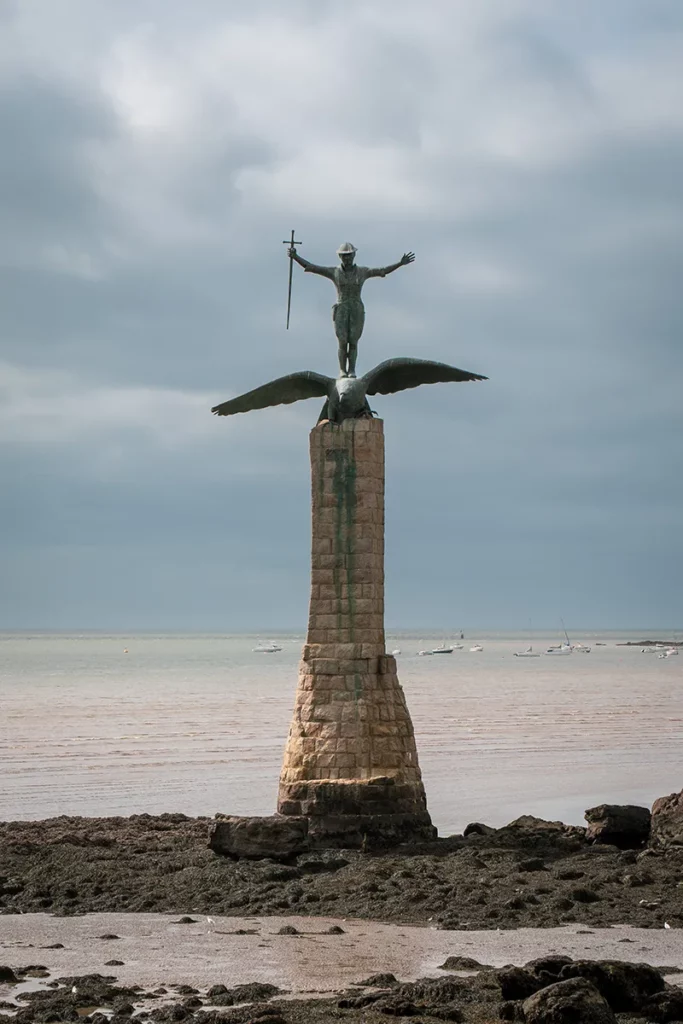
During the inter-war period, the French government encouraged aircraft construction away from the border with Germany. Saint-Nazaire seized this new opportunity and began building aircraft.
The Second World War was particularly devastating for the town. Having become one of the strategic ports of the “Atlantic Wall” built by the German army, which installed a submarine base there, Saint-Nazaire was the target of numerous bombardments and one of the very last French towns to be liberated, 85% destroyed.
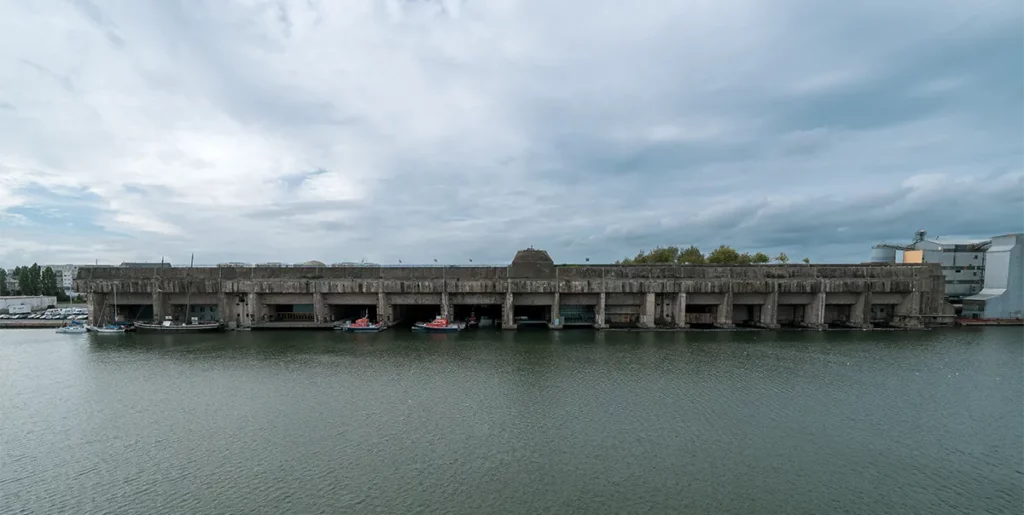
Today , Saint-Nazaire is a modern and dynamic city, with a diversified economy that still includes shipbuilding, but also the aeronautical industry, renewable energy and tourism. The town is also known for its beaches, its deep-water port and its role as France’s maritime transport hub.
Since the early 2000s, Saint-Nazaire has capitalised on its history to offer a rich cultural and heritage offering, while preserving its natural beauty spots and offering top-class gastronomy.
Visiting Saint-Nazaire: 10 must-do activities
Walking around the port.
To start your discovery of Saint-Nazaire, take the time to stroll around the town centre.
Obviously, in this seaside town, activity revolves around the port. Along the piers you can breathe in the fresh sea air and watch the boats come and go.
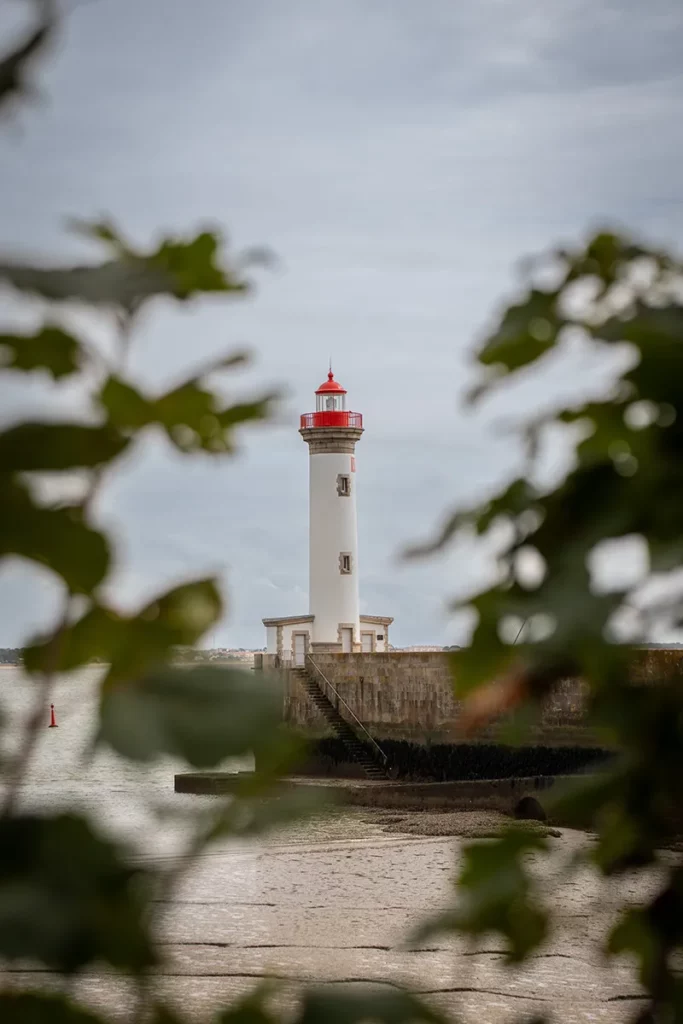
Visit the ecomuseum to learn about the town’s history
To really understand how Saint-Nazaire was built, open the door of the ecomuseum. With a host of scale models, you can see how the town developed and admire some of the finest ships and aircraft to have come out of the region’s factories!
It’s a very enjoyable visit for the whole family, thanks in particular to the tour guides designed especially for young visitors.
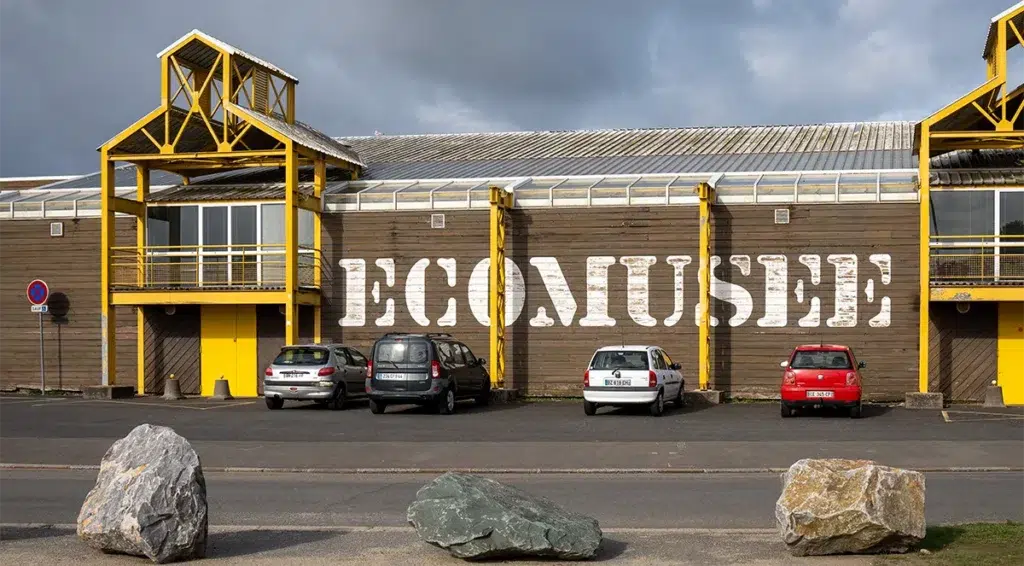
Address: 15 avenue Saint-Hubert Opening Hours: Daily, 10am to 1pm and 2pm to 6pm Admission: Adults €5; Concessions €4; children aged 4-17 €2.5; free for children under 4 Tickets at: saint-nazaire-tourisme.com
Embark on Escal’Atlantic: the interactive museum
Why not take a cruise aboard a legendary ocean liner? That’s – almost! – what Escal’Atlantic has to offer, an immersive museum that will give you the impression of embarking on a transatlantic voyage. On board, you’ll find a wealth of explanations about the ships that made up Saint-Nazaire’s golden age, as well as reconstructions of the cabins using objects from the period. You can go down into the engine room, relax on a deckchair facing the ocean or have a drink in the museum bar. It’s a must-see!
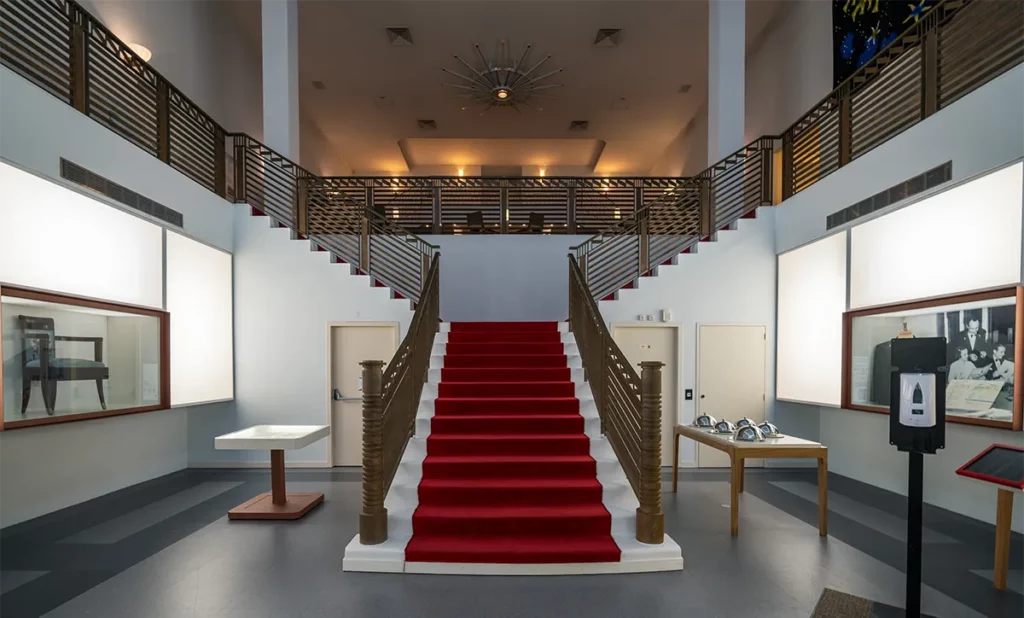
Address: 16 boulevard de la Légion d’Honneur Opening hours: Daily, 10am to 1pm and 2pm to 6pm Admission: Adults €15; Concessions €13; children aged 4-17 €7.5; free for children under 4 Tickets at: saint-nazaire-tourisme.com
Take on the role of a sailor and visit the submarine Espadon
In the submarine base, right next to Escal’Atlantic, discover the submarine Espadon! Built in the late 1950s and commissioned in 1960, it was the first French Navy submarine to dive under the ice pack, and could take on board up to 65 crew members.
You can now visit it with an immersive tour designed for all ages. Equipped with an audio guide, you can follow in the footsteps of a secret mission to the North Pole.
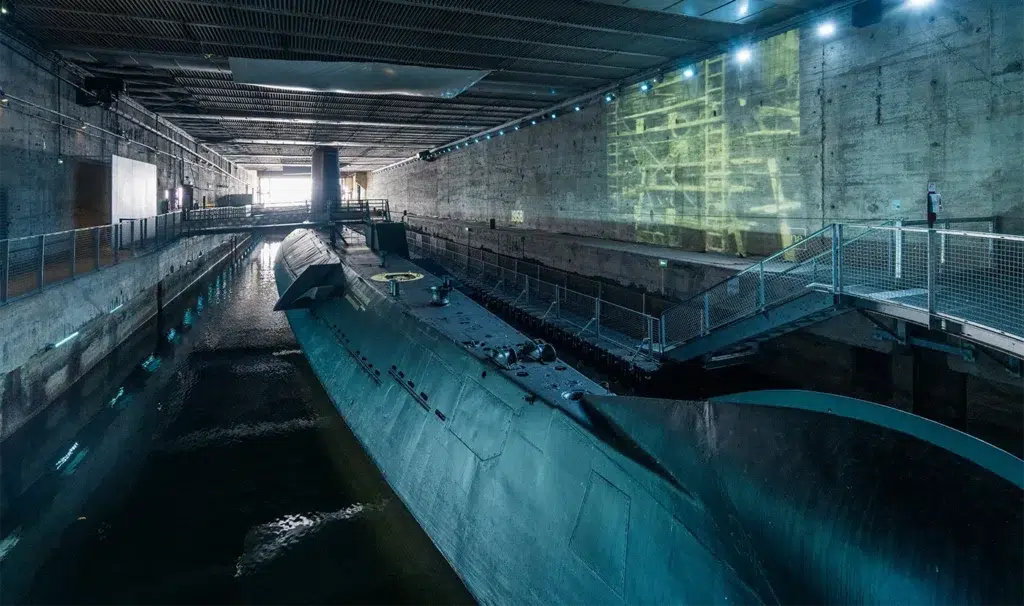
Address: 2 avenue de la Forme Ecluse Opening hours: Daily, 10am to 1pm and 2pm to 6pm Admission: Adults €12; Concessions €10; children aged 4-17 €6; free for children under 4 Tickets at: saint-nazaire-tourisme.com
Visit the Airbus and Chantiers de l’Atlantique industrial sites
Saint-Nazaire is now a major industrial town, home to the Chantiers de l’Atlantique shipyard and one of the Airbus sites.
You can discover these industries on guided tours organised from the submarine base, which will take you to the assembly sites for aircraft and the biggest ships.
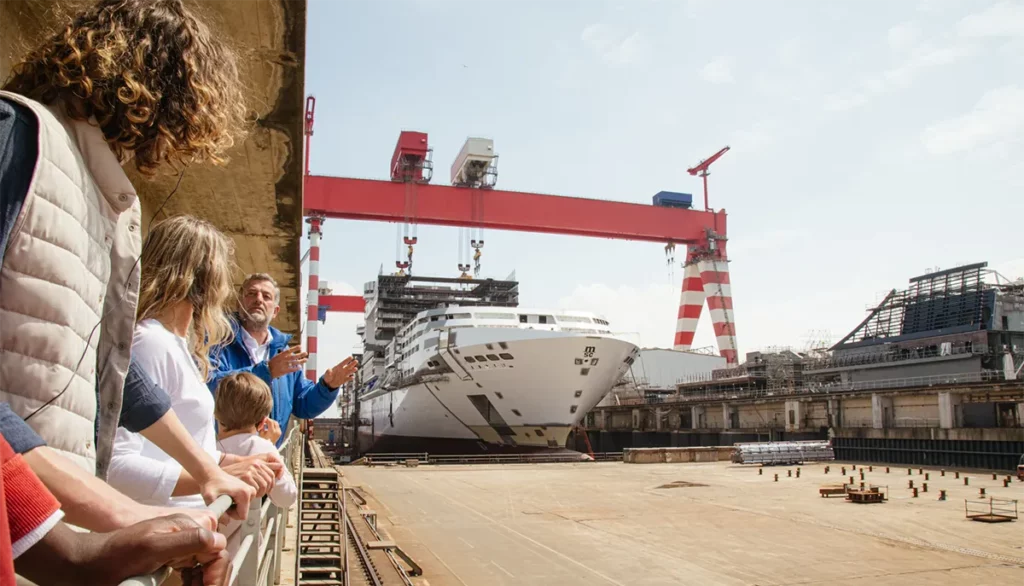
Hunting for street art
Saint-Nazaire is an open-air museum thanks to the many giant murals scattered around the town.

Don’t forget to climb up onto the panoramic terrace of the fortified lock to admire Felice Varini’s series of triangles, a work in anamorphosis that is revealed when you position yourself at a precise point that you’ll have to look for!
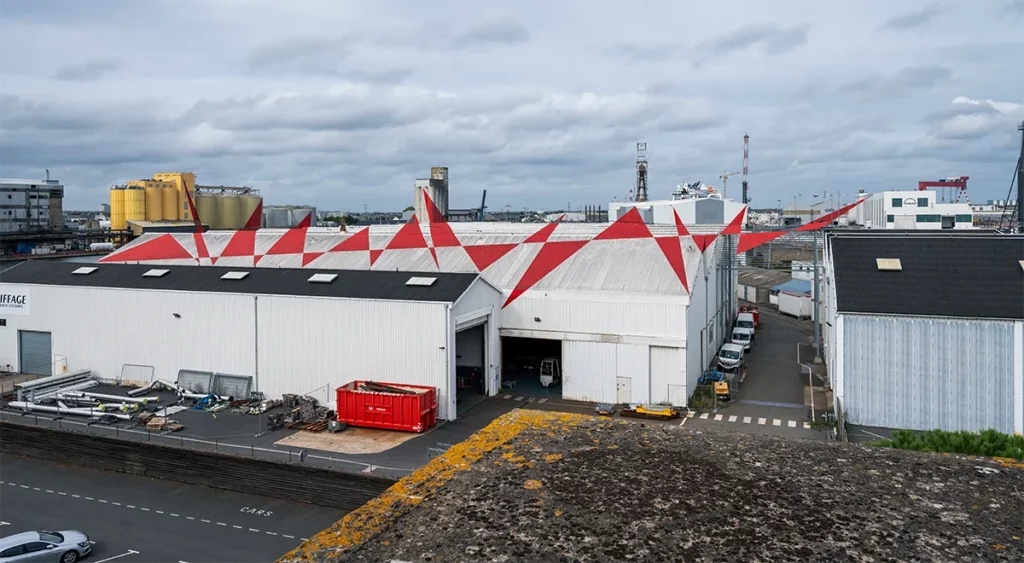
Strolling (or sunbathing!) on the beach
There’s more to Saint-Nazaire than its port and industrial life! This seaside town has no fewer than 20 beaches and coves. Right in the centre of town, you can easily put your towel down or take a stroll with your feet in the sand, but I’d advise you to go further afield to discover even more natural areas.
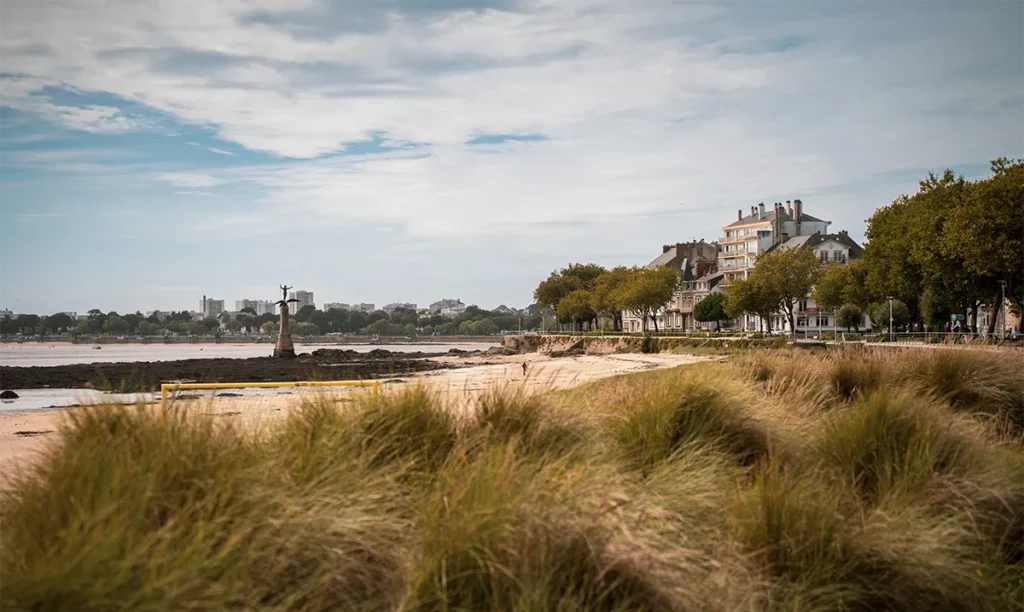
In the Saint-Marc-sur-Mer district, you can admire Monsieur Hulot beach, named after the main character in Jacques Tati’s film “ Les vacances de monsieur Hulot “, which was shot here.
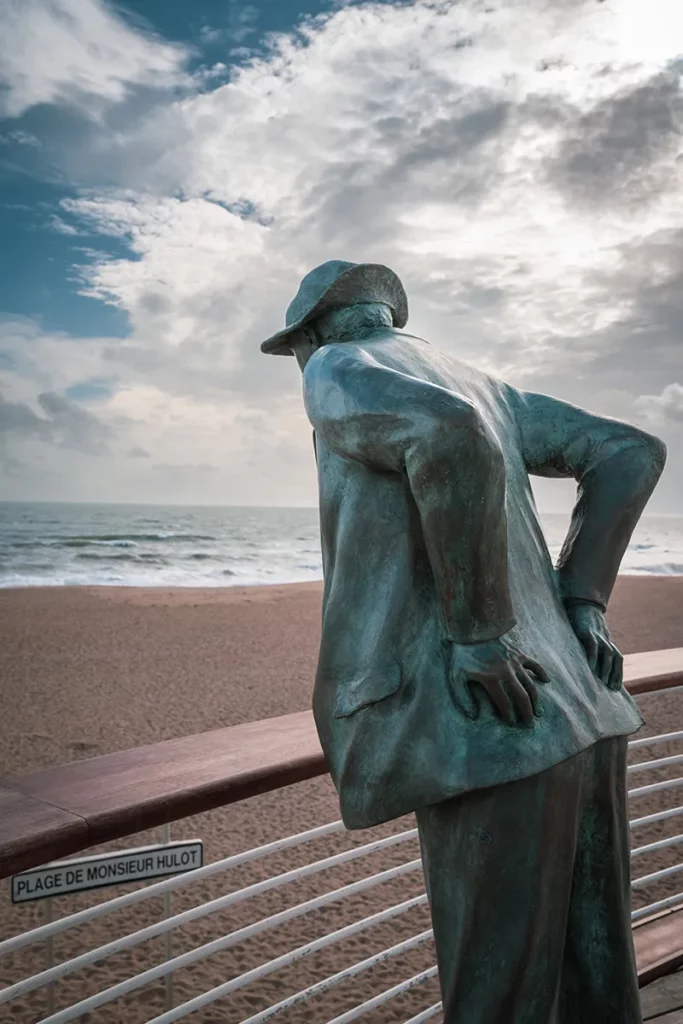
A few hundred metres away, the Trébézy fisheries reveal a wilder landscape.
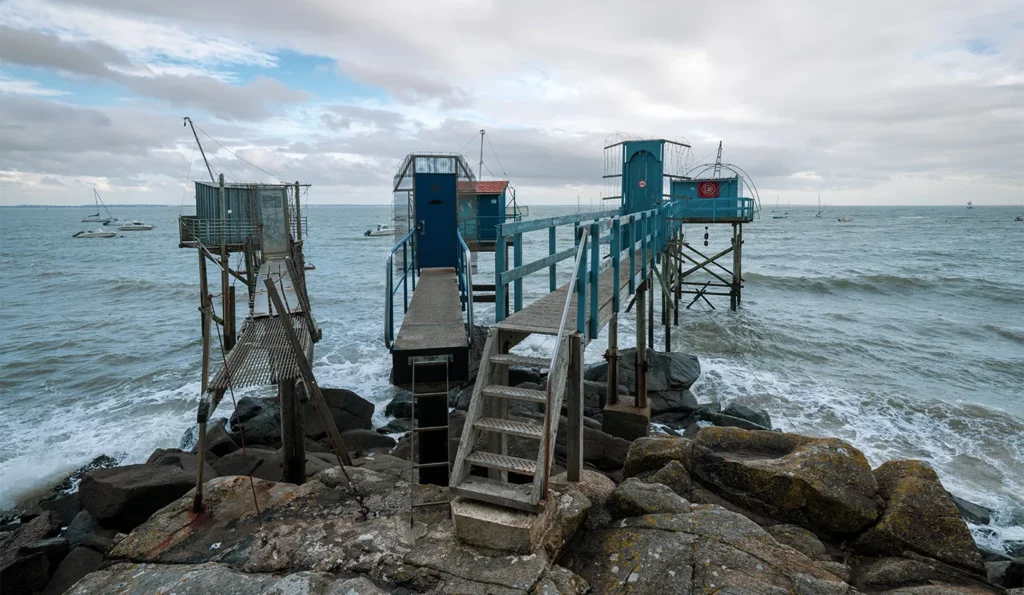
Going to Brière
Inland, discover La Brière, a Regional Nature Park and France’s second-largest marshland after the Camargue. Here you’ll be able to admire some 900 different plants as well as numerous birds. A 100% nature walk!
Sitting down at a good restaurant
Saint-Nazaire is no slouch when it comes to gastronomy. There are fine restaurants to suit all budgets. Of course, you’ll find plenty of fish dishes here, but vegetarians and meat lovers will also find something to their liking!

If you feel like doing a bit of shopping before you leave, there are several good places to visit:
- Le Ruban Bleu: this is an open-air shopping centre where you’ll find major national chains.
- Les Halles: in this market you’ll find more food shops with regional producers. Perfect for doing a bit of shopping and preparing a picnic! And don’t forget to take in the architecture of these covered market halls, which have been designated a 20th century heritage site.
- Le Garage: just a stone’s throw from Les Halles, Le Garage is a creative, innovative and cultural venue where you can meet artists and craftspeople who sometimes sell their creations.
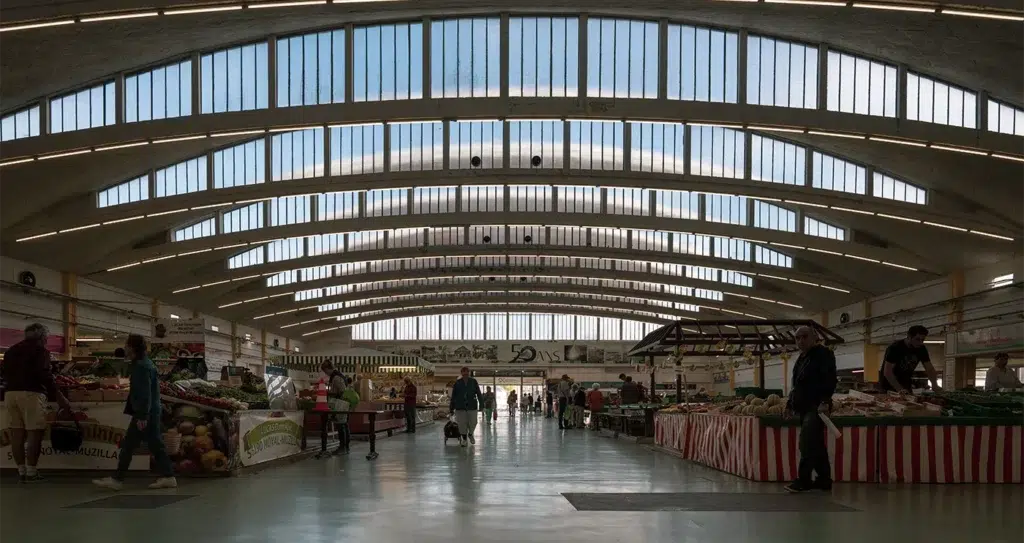
Where can you pack your bags in Saint-Nazaire?
There is a wide range of accommodation on offer, including hotels, gites and guest houses. There’s something to suit every budget. Use this map to find the list of available accommodation by entering the dates of your stay:
I particularly recommend ” La tête sur l’oreiller”, a bed and breakfast located right in the heart of the city, making it easy to do everything on foot.
Agnès, the lady of the house, has turned it into a warm, lively and welcoming place. Rooms start from just €60, including breakfast.
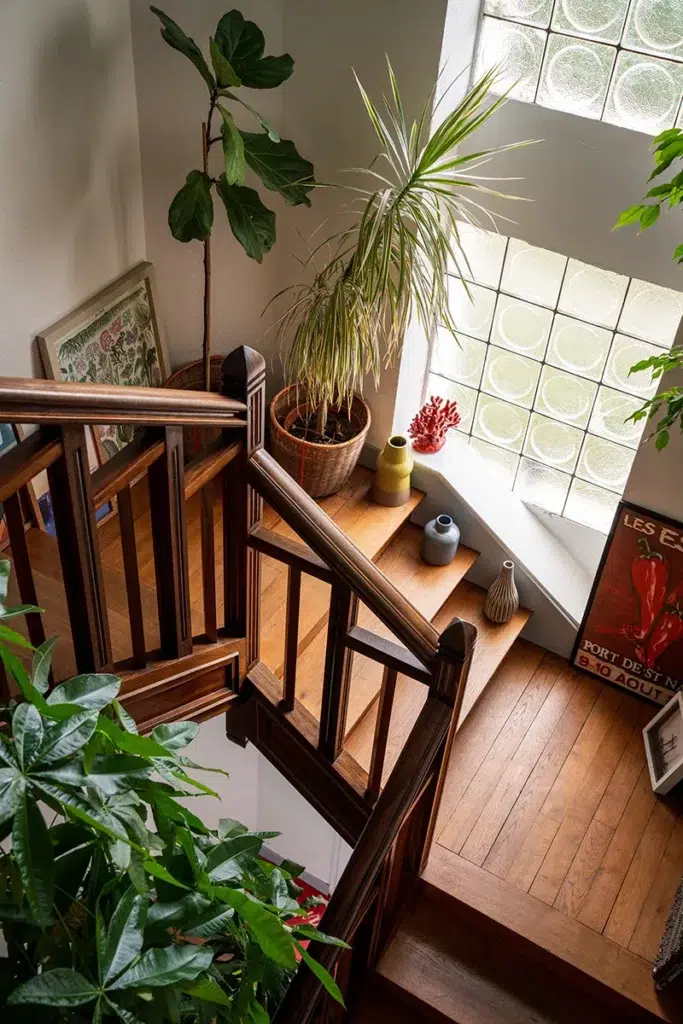
Map of good addresses in Saint-Nazaire
Don’t lose your way! Use this interactive map to find all the addresses mentioned in this article.
Tip: use the menu on the right to filter addresses according to your points of interest.
Article produced in partnership with Saint-Nazaire Tourisme Many thanks to Jérôme, Arnaud, Aurélie, Tiphaine, Mathieu, Agnès and everyone I met during my stay for their warm welcome.
No Comments
Your email address will not be published. Required fields are marked *
Post comment Loading
This site uses Akismet to reduce spam. Learn how your comment data is processed .

Abonnez-vous à la Newsletter
Chaque mois, recevez le meilleur de Culturez-vous dans votre boite mail !
Merci ! Consultez votre boite mail pour valider votre inscription.
- Regions of France
- French Departments
- Atlantic Coast
- Centre-Val de Loire
- Champagne-Ardenne
- Loire Valley
- Midi-Pyrénées
- Nord Pas de Calais
- Poitou-Charentes
- Provence-Alpes-Côte d’Azur (PACA)
- Battlefields & Memorials
- Museums & Art Galleries
- Theme Parks
- Christmas Markets
- Cruises/Canals
- Walking & Cycling
- Towns & Cities
- Travel to & around France
- Accommodation
- Restaurants

Guide to Saint-Nazaire
This guide to Saint-Nazaire will, I hope, inspire you to visit. I went there not knowing what to expect and very rapidly fell in love with this great Atlantic coast city that is re-inventing itself so successfully.
Saint-Nazaire has two sides. If you’re interested in shipbuilding (Saint-Nazaire has one of the world’s biggest shipbuilding yards), World War II history, submarines, ocean liners, wind farms and Airbus it will certainly be on your list.

But Saint-Nazaire has another delightful side: with old buildings, glorious beaches, lovely walks both long and short, picturesque fishing huts, good restaurants and a little naval shopping.
Saint-Nazaire’s Mixed History
Originally just a simple fishing village, Saint-Nazaire became a major port with the coming of the railways in the 19 th century. Vast new docks were built and Saint-Nazaire replaced Nantes as the main harbour on the Loire estuary emptying into the Atlantic Ocean. Perhaps inevitably it became known as the Liverpool of the West, or if you’re on the other side of the Atlantic, Little Breton California.

By the end of the 19 th century, Saint-Nazaire was the main port building luxury ocean-going liners.
At the start of World War II the port was used to evacuate British troops. A major disaster occurred when the Clyde-built cruise liner SS Lancastria, requisitioned to carry British troops back from France, was sunk by German Junkers bombers in just 15 minutes. Winston Churchill banned all news coverage of the worst disaster in British maritime history (around 4,000 troops were killed) and the incident remained unknown.

In June 1940 France surrendered. The Germans occupied Saint-Nazaire and built the heavily fortified, impregnable U-boat submarine base so vital for destroying the Atlantic supply ships. Saint-Nazaire became a strategic target and in January 1943 the Allies bombed the town, burning it to the ground – though the submarine pens remained.

After the liberation of most of France in 1944, German troops who were holed up in the submarine base refused to surrender but with no supply line they were powerless. General Eisenhower ignored the German bases along the west coast and Saint-Nazaire stayed under German control until after the end of the war in Europe on May 8, 1945.
Saint-Nazaire was rebuilt in the late 1940s so there’s a lot of fairly mundane housing, flats, offices and shops. But is is changing rapidly and the seaside is being developed sympathetically.
Top Attractions in Saint-Nazaire
Start at the Submarine Base

The German submarine base was too strong to demolish without huge cost. Today it’s a major tourist attraction, housing the Escal’Atlantic Museum , a café, a bar and Saint-Nazaire Tourist Office. Get your tickets here for tours of the major industrial sites. It’s also the starting point for the coaches that take you to the shipbuilding yard and to Airbus.
Back to the other Saint-Nazaire Attractions
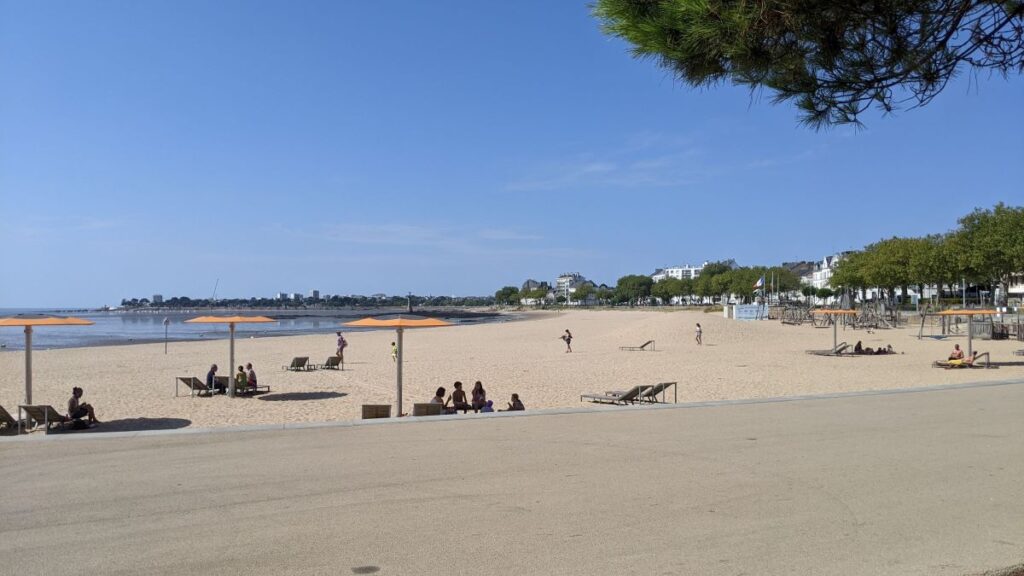
Make for one of the 20 beaches in and around Saint-Nazaire. There’s plenty of choice. Try the long sandy central beach for watersports, or find yourself a bit of peace and quiet on a cove around Port Charlotte to the west at La Courance or Trébézy.
Walk Beside the Sea
The long promenade beside the sea starts in the east at the Place du Commando by the entrance to the port. Large placards along the walk show the story of Saint-Nazaire; people stroll, cycle or run while others sit on the benches looking out to sea.

Take time for a detour through a small area known as La Havane. Many of the shipbuilders lived in the old houses that line the streets of Santander, La Havane and Veracruz, streets named after the destinations of their cruise liners.

Look out for ‘Sammy’, built in 1927. The monument commemorates the 198,000 US soldiers stationed in Saint-Nazaire from 1917 to 1919.

You’ll pass small fishing huts, reached by wobbling little passageways from the shore. Privately owned, the owners use them to fish, lowering the large nets hopefully but usually unsuccessfully into the water. Otherwise they are there just to sit and watch the ever changing seascape. You can hire them; we spent an hour or so in one – a glorious, restful experience. Hire a Fishing Hut
Look out for Tintin
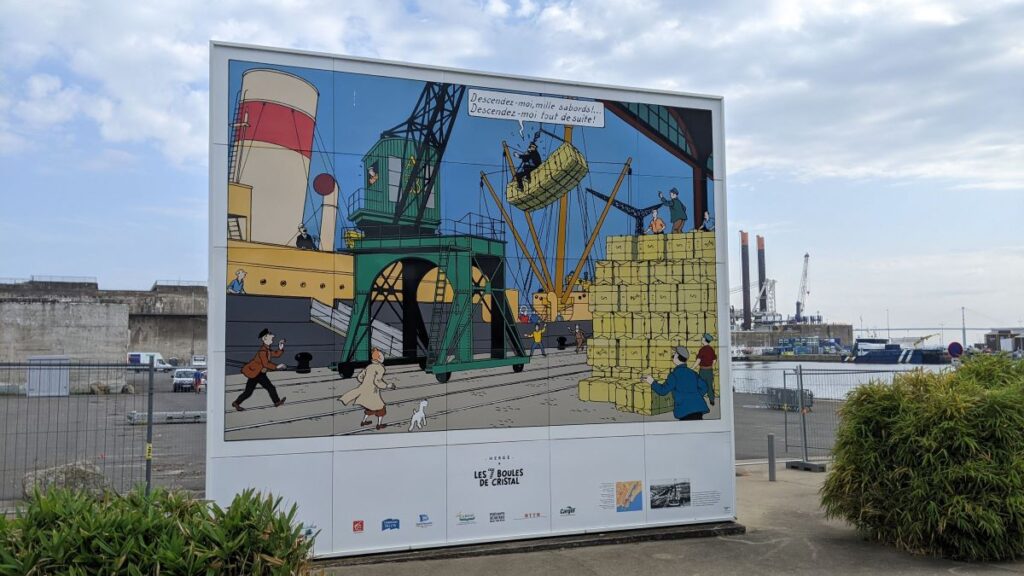
You’re not the first illustrious visitor to Saint-Nazaire. 6 boards and an orientation table mark the places in the comic book Les 7 Boules de Cristal visited by Tintin, Captain Archibald Haddock and Milou. “ Et puis, pensez donc: Saint-Nazaire, le port, les quais, l’océan, le vent du large, les embruns qui vous fouettent le visage…” “ And then, just think: Saint-Nazaire, the port, the quays, the ocean, the offshore wind, the spray that whips your face… “ Pick up the little leaflet at the Tourist Office and set off on your Tintin journey.

Housed in a small building in the old port area, the Éccomusée museum tells the story of Saint-Nazaire’s history and industrial heritage, of the port area and the great ocean liners that were built in the city.
It’s a small museum but with enough models, maps, artefacts and photographs to take you through thousands of years of history in a delightful, digestible way.
There are plans for a new museum, but for the moment, take time for a visit and take the family. Here’s a very good guide to L’écomusée from mechtraveller.com.
Follow the Daring Operation Chariot Raid

Saint-Nazaire was a huge problem for the Allied troops in World War II. The port and the great submarine pen housed the battleships and U boats used by the Germans to destroy the Atlantic convoys that took vital supplies from America to Britain.
Two great battleships occupied Saint-Nazaire: Bismarck and Tirpitz . Bismark was sunk in May 1941 after a fight in which the British ship HMS Hood was also sunk. Tirpitz remained.
Mountbatten came up with an audacious and extremely dangerous plan. Bombing was not possible as Saint-Nazaire was too heavily defended. So the massive Joubert dock, where Tirpitz was stationed, became the target. Or rather the seaward lock gate was the target. The idea of what became known as Operation Chariot? To destroy the gate with a ship packed with explosives rammed into the gate. And, if possible, to wreak more havoc on other sea locks into the basin where the submarine base was located.
The ‘Greatest Raid of All’ was launched by an old destroyer, HMS Campbeltown , loaded with explosives and accompanied by patrol boats carrying commandos whose job it was to go ashore a little further out and attack locks and the German defences.

It was an extraordinary attack, one of those heroic, seemingly hopeless attempts that largely succeeded.
It’s a ripping good yarn, but if you want the full details, go to the excellent Mechtraveller.com story.
The whole point of this rather long introduction is to encourage you to follow the easy Operation Chariot trail. Pick up the leaflet from the Tourist Office to walk around the 7 panels that tell you the story at various times of the raid.
Walk the Coastal Path
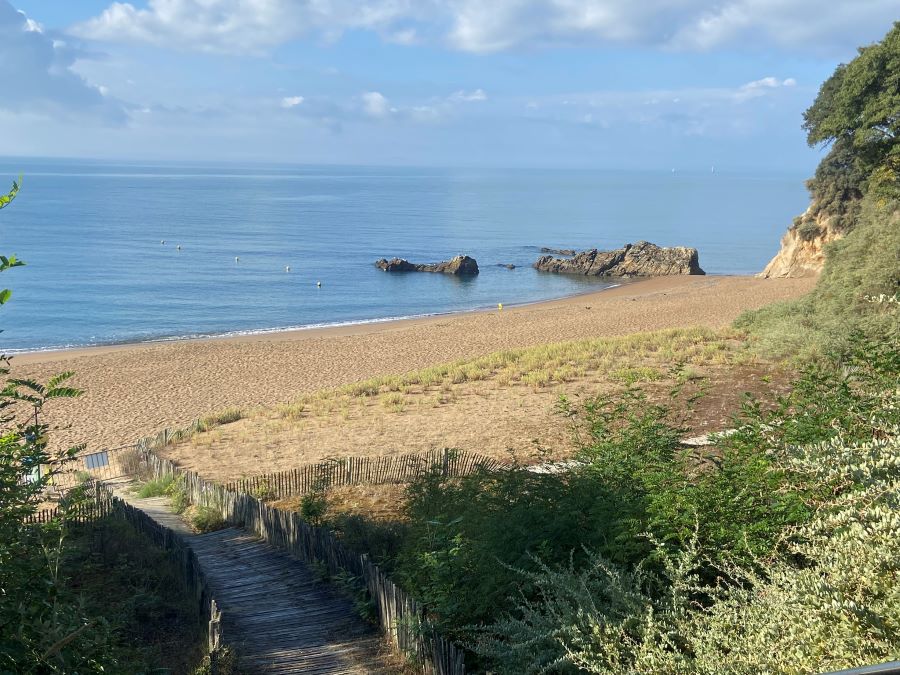
The famous coastal path, GR34, starts in Saint-Nazaire and runs north along the Brittany coast for over 2,000 kms/1,240 miles. It finishes at Mont-Saint-Michel. It’s not new; the original trail was created by customs officers in 1664 to intercept smugglers. It takes about 3 hours to walk the Customs Officers’, or Smugglers’ Path as it’s known, from Place du Commando to Plage de Sainte-Marguerite in Pornichet (14 kms/8.6 miles). It’s well worth the effort. Or just go for a few kilometres; the views are stunning.
Where to Stay in Saint-Nazaire
We stayed at the Originals City Hôtel de l’Europe . The 3-star hotel had good rooms, breakfast and friendly staff. There’s a useful (paying) car park opposite.

Our second night was at a charming chambre d’hôte (bed and breakfast). La Tête sur l’oreiller is in the town centre and run by the helpful and friendly owner, Agnès. There are 5 large rooms including a family room, many looking out onto the peaceful back yard where there’s limited parking. No website, so get in touch directly: [email protected] .
Or try Le Berry , a 3-star hotel near the station. It has smart modern bedrooms and bathrooms, a brasserie and bar. Rooms from €70 in the low season and from €100 high season.
There’s a good selection of budget and chain hotels in Saint-Nazaire.
Where to Eat in Saint-Nazaire
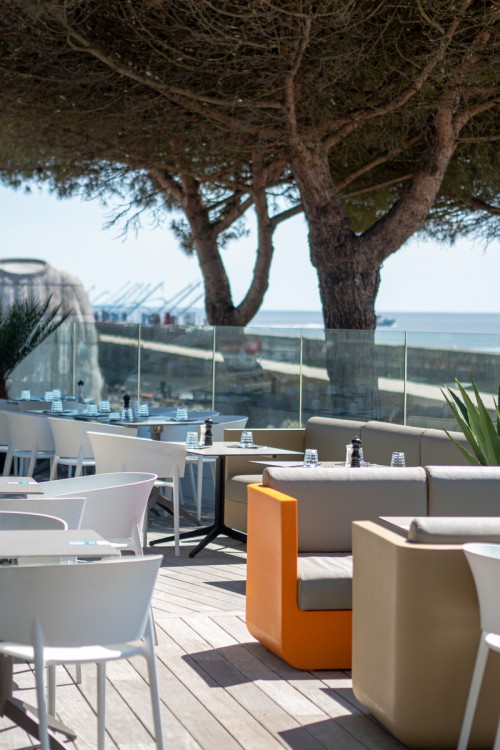
There are plenty of good restaurants in Saint-Nazaire. We ate at La Plage , one of the new restaurants in the Place du Commando. Top seafood dishes, great staff and a wonderful view of the sea.
Also in the Place du Commando, La Fabrik is a good choice for lunch (it closes at 7pm). Go here for waffles, vegetarian dishes, skewers of meat and vegetables, salads and steak and chips as well as ice creams. Tel: +33 2 51 16 96 74.
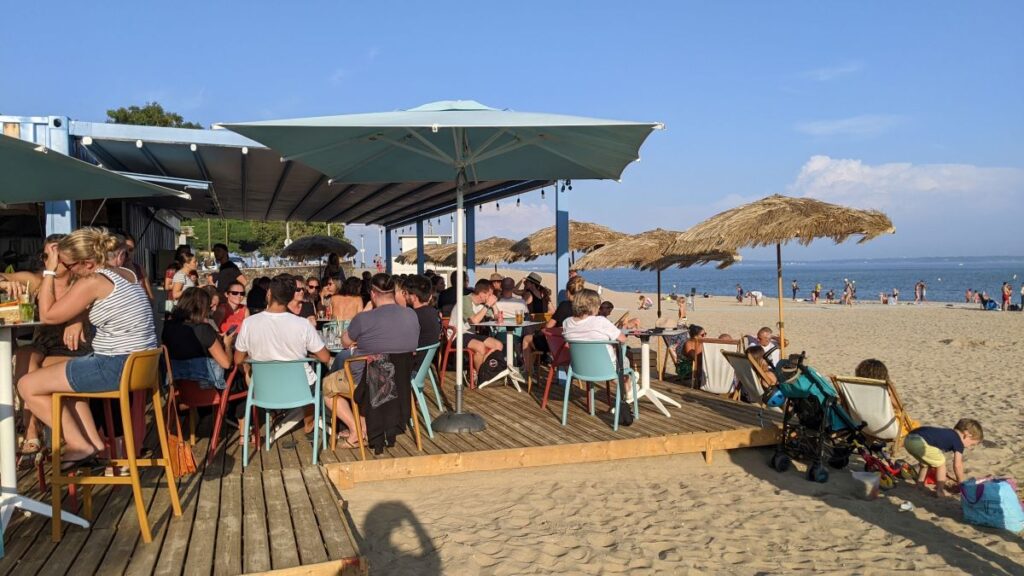
One of the most enjoyable casual meals was at Le Papillon , a bar/restaurant on the beach with extra tables on the sand. They do excellent plâteaus of charcuterie and cheese plus moules in large pans. It’s at Plage de Villès, about a 20-minute walk from the Place du Commando. Run by Igor and Melissa, who worked for 10 years in London in restaurants and bars, it’s only open in the summer.
We also had lunch at Le Maharaja , an Indian restaurant a short walk from the submarine base. First-rate tandoori dishes and classic Indian curries with a terrace for summer dining.
For a quick meal, or takeaway, try Basilic&Co . It’s a chain of good pizzerias, centrally located, friendly and good value.
Shopping in Saint-Nazaire
Saint-Nazaire is not known for its shopping. But walking to the submarine base from our bed and breakfast, I came across Comptoir de la Mer . And this sprawling shop was irresistible. Good clothing if you’re sailing, many different fishing rods, but best of all, those wooden lighthouses, birds and boats that place your bathroom right by the sea. I spent a small fortune.
Markets in Saint-Nazaire

The large main covered market, Les Halles was built in the 1950s. It’s the place for fresh vegetables, fruit, fish, cheeses and more, both French and international. It’s not particularly pretty but it’s a great place to shop for a picnic. Stalls both inside and out. Open Tues, Fri and Sun mornings. Blvd de la Legion d’Honneur. Saint Nazaire Villeport.
To the east you’ll find Penhoët Market in Méan-Penhoët. Built in 1877 it was brought here from the centre in 1936. Open Wed and Sat.
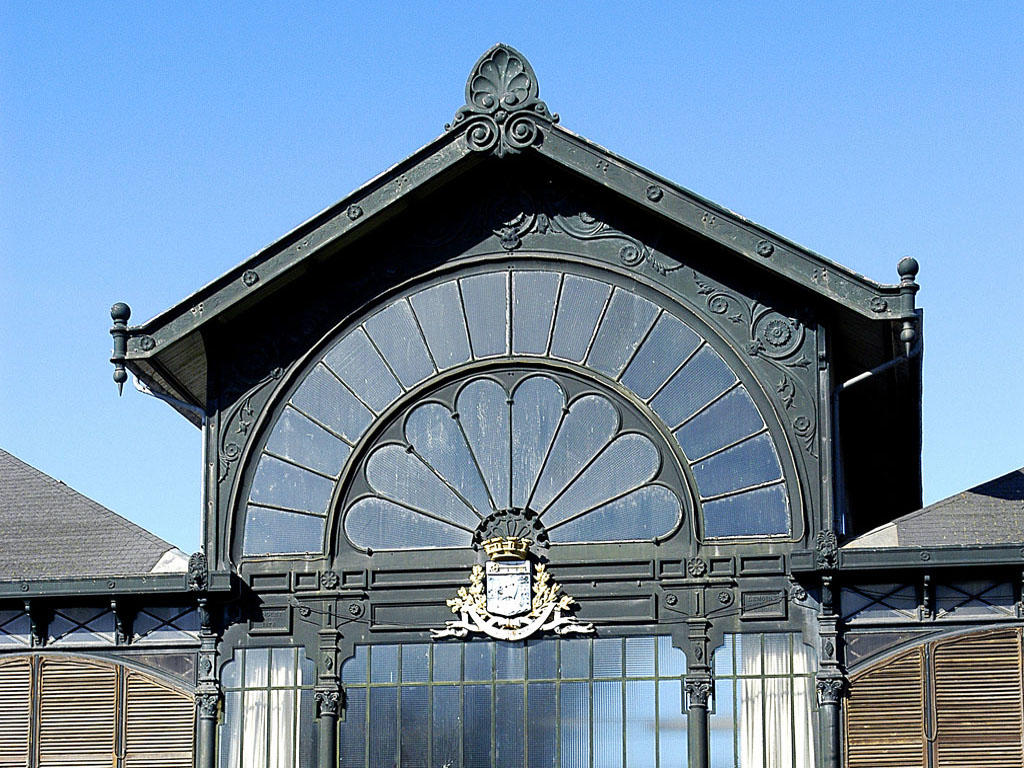
Saint-Nazaire Markets .
Great Places outside Saint-Nazaire
A serpent awaits.

Drive over the impressive Saint-Nazaire bridge then turn off immediately to Brevin-les-Pins. Park in the main car park and walk along the seaside path. It will take you to the 130-metre long Serpent d’océan , best seen at low tide.
Saint-Marc-sur-Mer and Monsieur Hulot

I was brought up on Monsieur Hulot’s Holiday , a hilarious black-and-white and very old-fashioned film starring Jacques Tati. It’s become part of the folklore of France but I had no idea that the village was just a 17 km/10.5 mile drive along the coast from Saint-Nazaire and that the French had taken Monsieur Hulot quite so much to their hearts.

There are various walks and view points, helpfully shown on boards around the village relating to the holidaymaker who creates havoc in the small seaside resort.
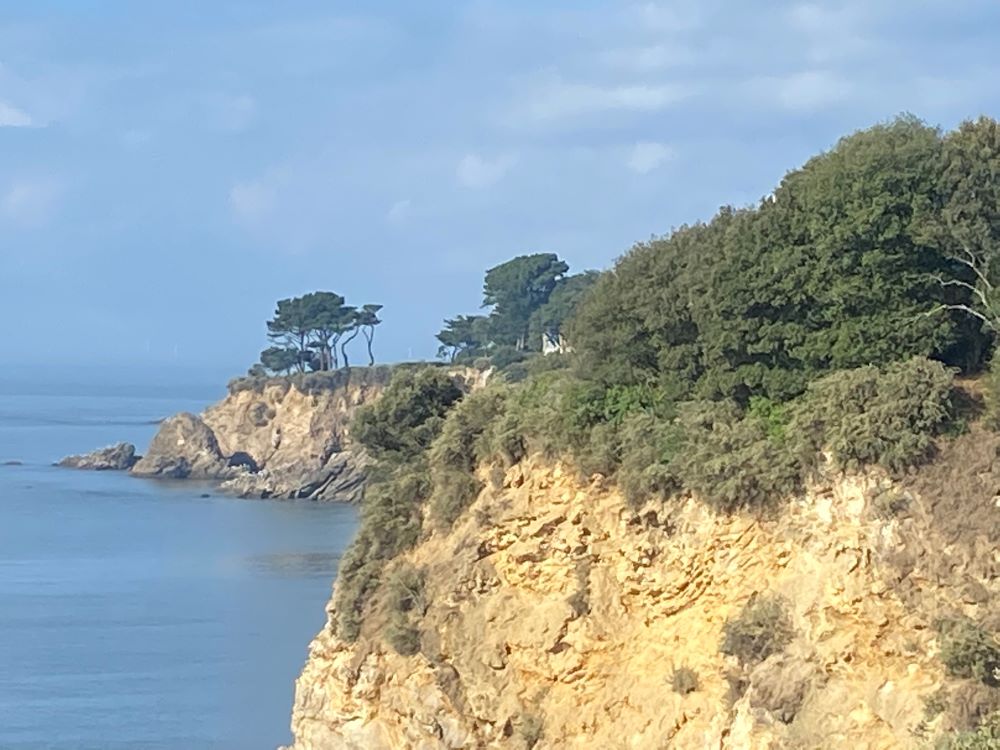
Walk along the Smugglers’ Path (part of GR34), take bathing gear, walk down the steps from the path and swim in the blue waters of the sea.
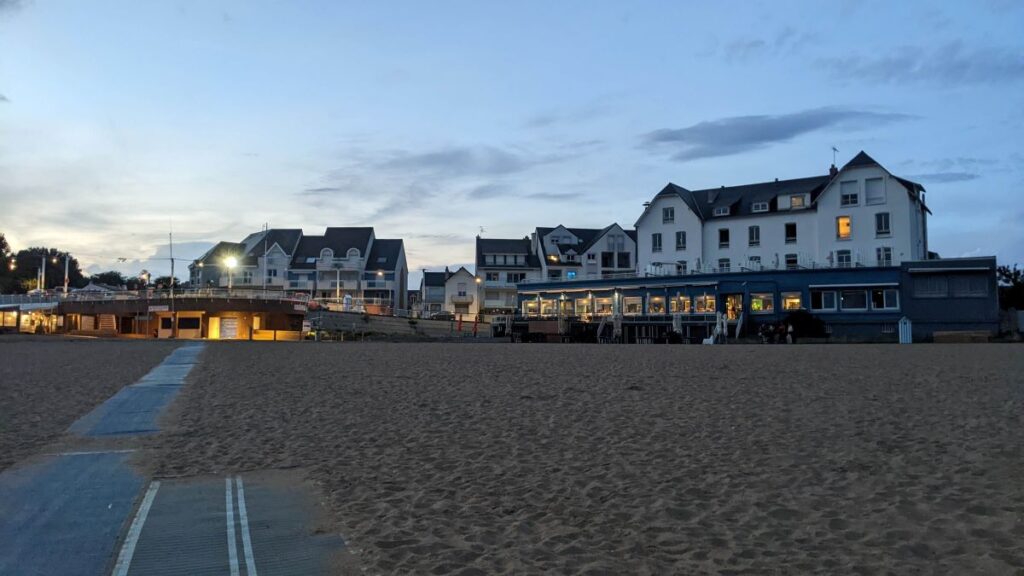
Stay in the excellent 3-star Best Western Hôtel de la Plage , M. Hulot’s hotel. With a room looking out over the beach and the sea, and a view of M. Hulot himself standing on a rampart with exactly the right pose, it makes a great end to a stay in Saint-Nazaire. Good bar, restaurant and terrace dining.
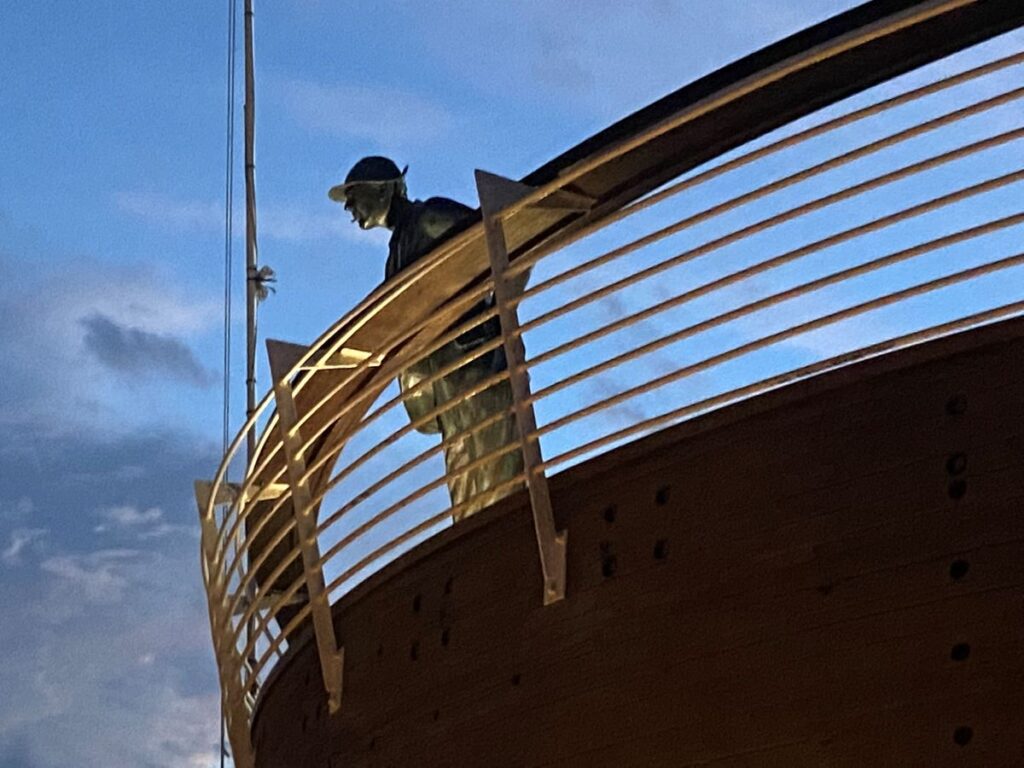
We ate at an excellent Asian style dinner (dishes from €16.50) at Le Centre in the middle of the village. On Sundays there’s live music at 4pm.
Go Further Afield
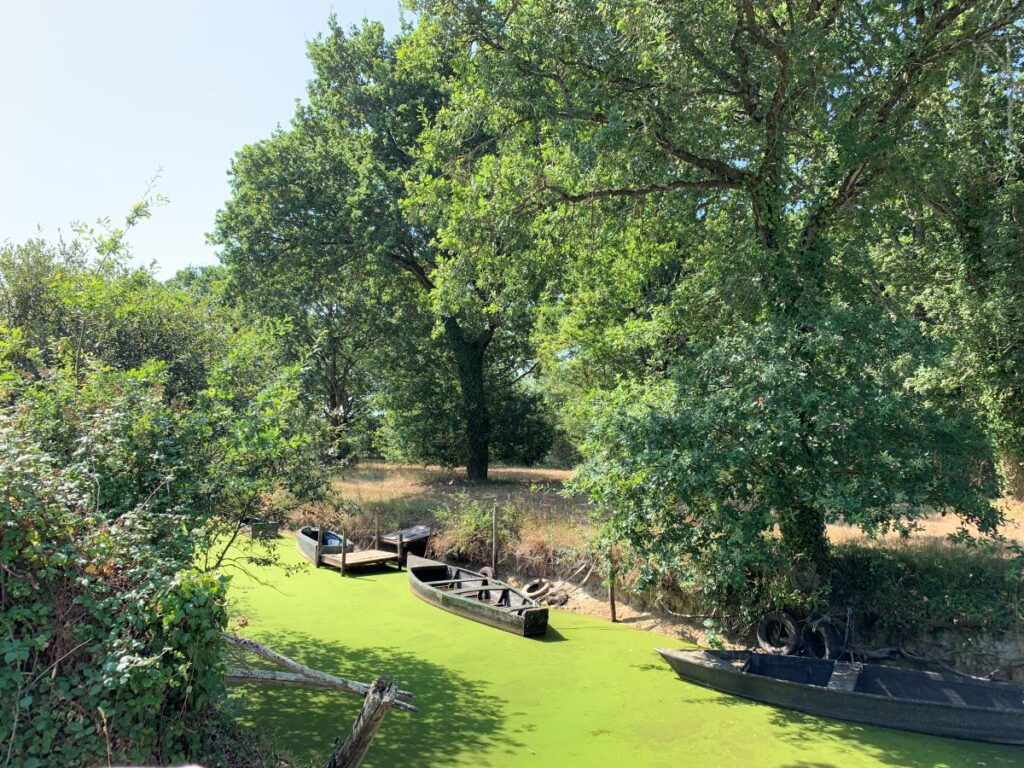
Just to the north of Saint-Nazaire you’ll come to the Parc naturel regional de Brière . France’s second largest wetland is a glorious area of villages, natural ecosystems, animals and thousands of birds.
Salt Marshes of Guérande
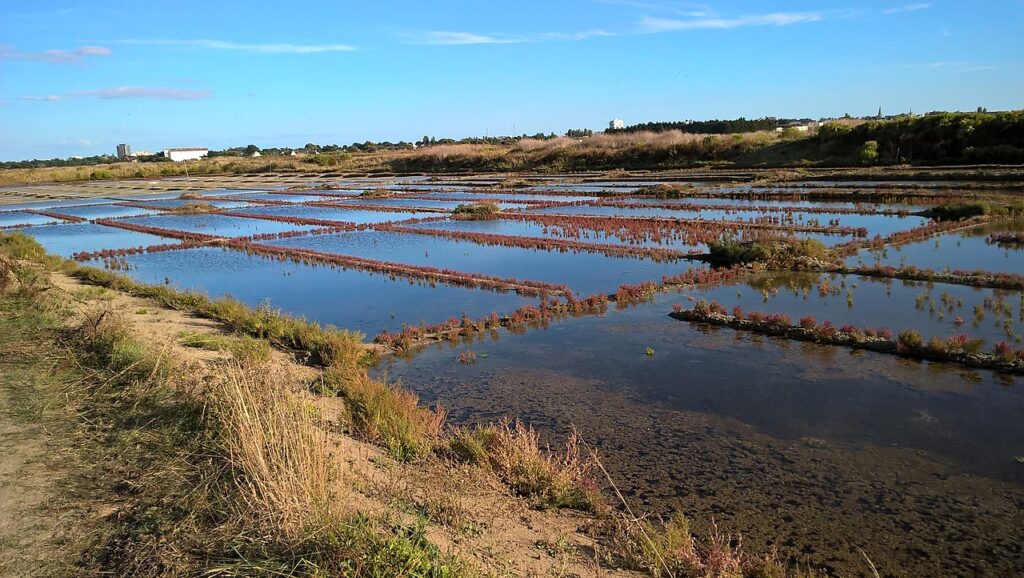
Go north west and you’re in the salt-marshes of Guérande. In this huge low-lying area, the precious (and expensive) salt is produced naturally. The seawater flows through the pans producing brine.
Stop at Terre de Sel , one of the businesses producing salt. There are plenty of food stuffs to buy and they also arrange guided tours of the salt marshes.
Read about the Industrial Heritage of Saint-Nazaire : Shipbuilding, Submarines, Airbus and Wind Farms to visit.
Practical Information
Saint-Nazaire Tourist Office Brittany Tourist Office Atlantique-Loire Valley Tourist Office
How to get to Saint-Nazaire
Saint-Nazaire is in Brittany, in the Loire-Atlantique region.
By car: The nearest ferry port from the UK is St-Malo used by Brittany Ferries. It’s around 200 kms/124 miles and takes around 2 hrs 30 mins. We came from Dieppe on DFDS ferries, around 500 kms/310 miles taking around 5 hrs. More about Ferries to France from the UK.
By Train: Take the TGV non-stop train from Paris Montparnasse to Nantes (2hrs 7 mins). Then take the local TER train from Nantes to St Nazaire (47 mins).
By Air: Major European airlines fly to Nantes, as do budget airlines like easyJet and Ryanair. They fly from UK and European destinations. Catch the shuttle bus to the railway station.
More about the French Atlantic Coast
French Atlantic Coast Guide from Brittany to the Spanish border. Drive along the Loire Valley from Saumur to Saint-Nazaire
Declaration: I was on a self-driving press trip as a guest of the Saint-Nazaire tourist office. Apart from the Hotel de l’Europe & meal at Basilic&Co, the tourist office covered all meals, accommodation and entry fees.
Privacy Preference Center
Consent management, advertising.
The site of Saint-Nazaire
Tourism, holidays & weekends guide in the corrèze.
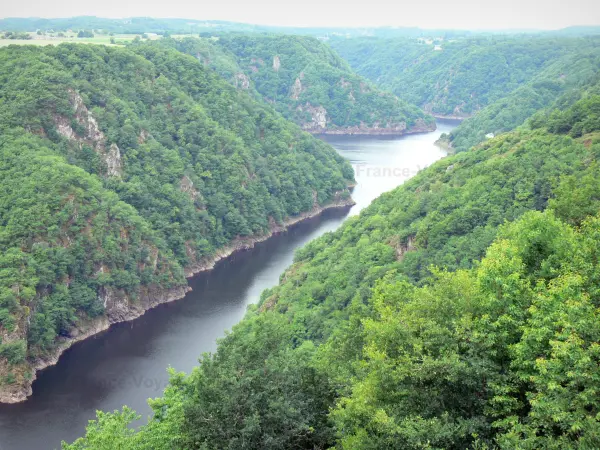
An impressive belvedere with views of the Dordogne and Diège gorges, the famous site of Saint-Nazaire, in Corrèze , is located 12 kilometres to the west of Bort-les-Orgues , in the municipality of Saint-Julien-près-Bort.
Nestling amid the greenery, this remarkable place is named after a legend: St. Nazarius is said to have driven the devil from the place. He left a forked hoof print on a rock as he fled in long strides… The statue of the saint, erected in 1901, still watches over the site, and a pilgrimage in his honour was organised every September along the Way of the Cross that ends opposite the abyss.
The pleasant and restful site of Saint-Nazaire is easily accessible on foot: you have to allow for 15 minutes' walk from the car park to reach the belvedere. Once you arrive, you can enjoy a wonderful view of the confluence of the Dordogne and the Diège! A peaceful and verdant setting, ideal for a picnic in the countryside…
Visit ideas nearby
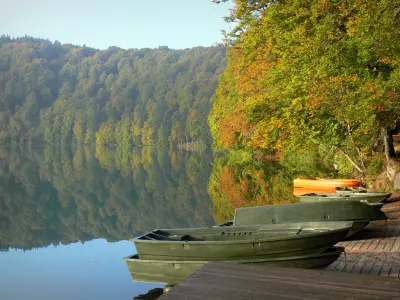
Related articles The site of Saint-Nazaire
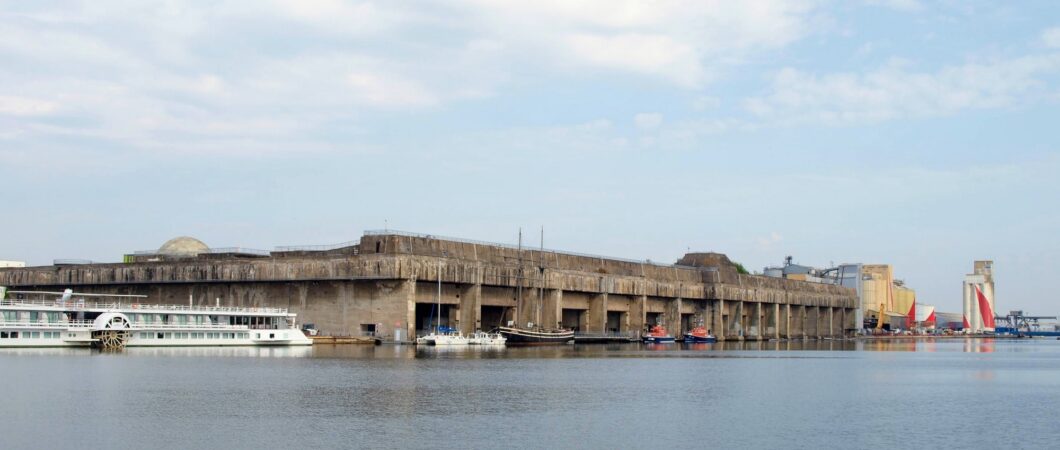
The U-Boat Base – Saint-Nazaire
These days, the huge fortified bunker built by the Germans in 1941 to protect its U-boats, is no longer referred to as the “U-boat base” or “the U-boat pens”. Instead they simply call it the ‘submarine base’, maybe to disassociate it from its origins, but we all know who built it and why.
Other Saint-Nazaire Posts
Soon after France was overrun in 1940, the Kriegsmarine (German Navy) started work on a number of U-boat bases on the French Atlantic coast in order to prosecute its U-boat campaign against the Atlantic convoys bringing war material, men & supplies to Britain. Covered U-boat pens were built at Saint-Nazaire, Brest, Lorient (6 bunkers*), Bordeaux and La Pallice (on the outskirts of La Rochelle).
These were huge bunkers, built by Organisation Todt ‘guest workers’, and the Saint-Nazaire base was one of the biggest. It was built on the site of the old CGT transatlantic shipping line docks. All the terminal buildings and warehouses on the site were demolished and work started in February 1941 on the middle section – pens 6, 7 & 8. They were completed in just four months. Then work switched to the remaining pens on either side, and the whole 14-pen complex was finished a year later in June 1942… although they went on reinforcing the roof and building annexes until June 1944.
During that astonishingly quick 16-month build they poured nearly half a million cubic metres of concrete. The completed base was (still is) 299 metres long (that’s almost a third of a kilometre!) by 124 metres wide and was 18 metres tall (980ft x 400ft x 60ft). With a reinforced concrete, granite & steel roof layered up to 8.75m (29ft) thick, it was pretty much impenetrable to bombs.
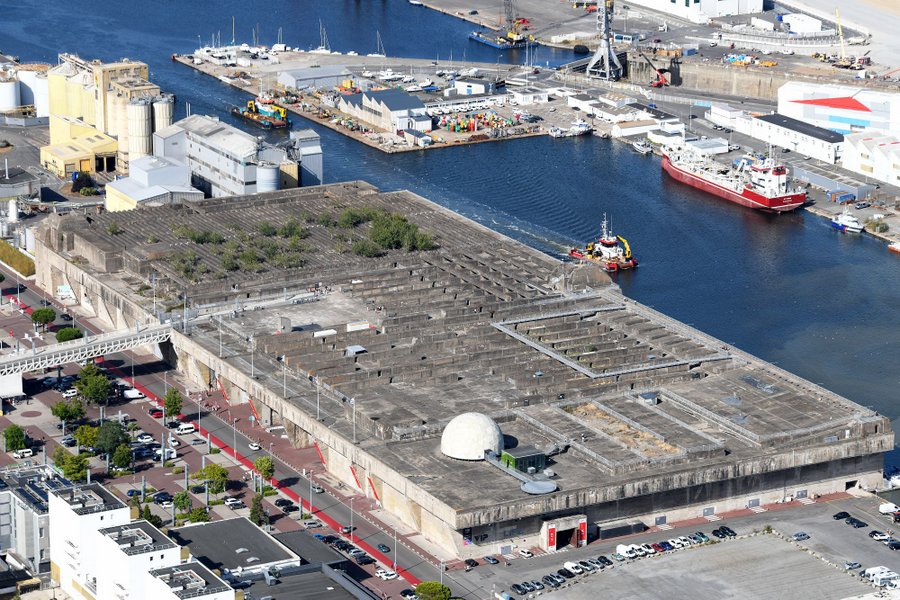
The 14 pens could hold up to 20 U-boats at a time. Pens 1 – 8 were dry docks for working on single submarines. Pens 9 – 14 were wet berths, each holding two U-boats, where they could be repaired and provisioned.
The whole base was a small city for repairing, replenishing & maintaining the U-boats. There were dormitories for workers**, kitchens, and a hospital in the annexes, and workshops and stores in the bunker itself. The whole of the back wall (landside) was filled with specialist workshops and stores. For example at the back of Pen 2 was the deck gun workshop and armourer; opposite Pen 4 were the welders and drawing office; the electricians and their workshops could be found opposite pens 5 & 6; you need your periscope fixing? Try the periscope workshop opposite pen 7; oxygen bottles? You can find them in the stores opposite 8 & 9; small parts store? That’s opposite Pen 10; A dodgy motor or air compressor? Get it fixed in one of the workshops opposite Pens 13 & 14.
At the northeast end of the pens were the pumping stations for the dry-docks, offices and a bakery. In the two stairwell sections between Pens 5-6 and 12-13, which led to the roof, there were more offices, magazines, stores, laboratories, and small workshops. In total the bunker had 150 offices, 97 magazines and 62 workshops.¹
The Fortified Lock
The British Commando attack (Operation Chariot) on the massive Joubert (aka Normandie) Lock in March 1942 caused the Kriegsmarine to re-evaluate their defences. Although the U-Boat pens were not a primary target, one of the Motor Torpedo Boats, MTB 74, fired two delayed action torpedoes at the lock gates on the opposite side of the U-Boat base’s basin, which blew up the following day.
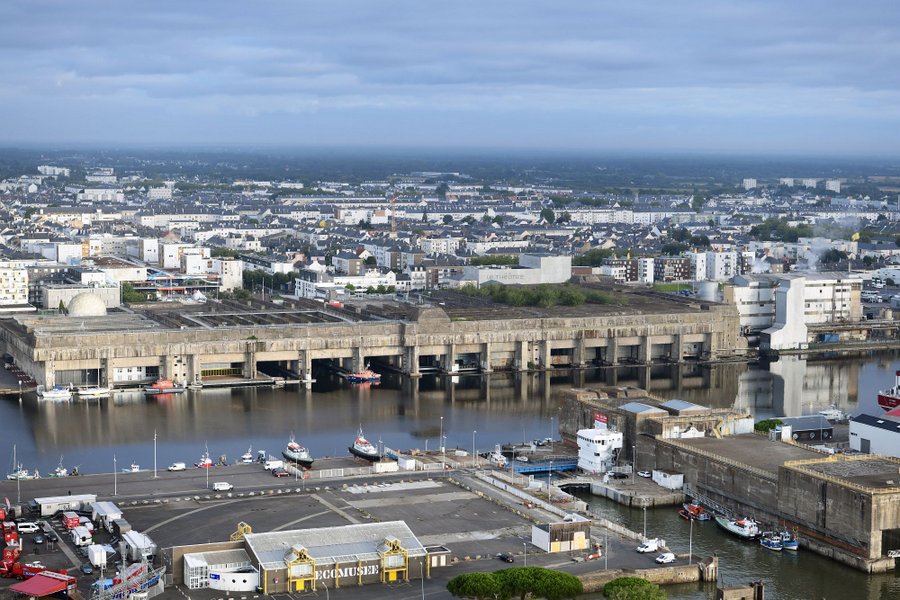
Even if U-boats were protected in the bunker, it highlighted how vulnerable they might be if attacked in the basin or locks, and how useless the base would be if the locks were damaged or destroyed leaving their submarines with no access to the sea. So, in 1943, the Germans started work on a new fortified lock protected by its own bunker.
It was completed in 1943 and was protected by 4 x 20mm AA guns and a heavy machine gun in a heavy steel dome, which you can still see on the roof today.
Saint-Nazaire U-Boat Base History
The base was home to two frontline U-Boat flotillas, the 6th & 7th.
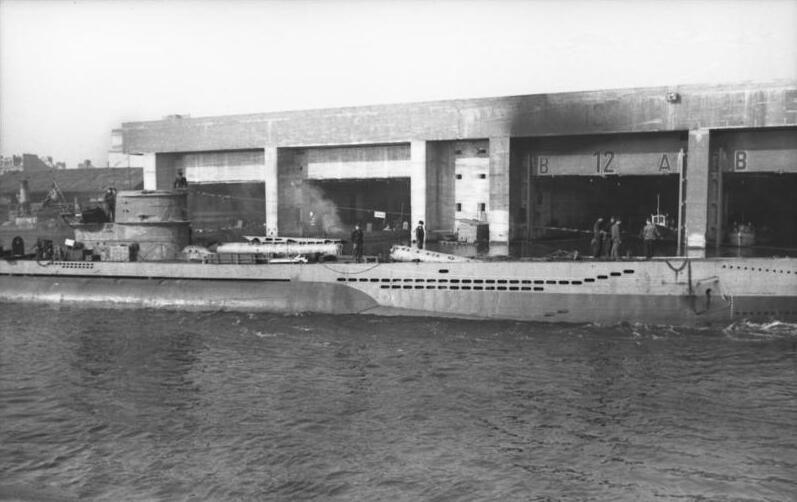
Elements of the 7th Flotilla, which had been operational since September 1939, transfered from Kiel to Saint-Nazaire between January – June 1941 and Vice Admiral Dönitz himself officially opened the base on the 30th June 1941. The 6th Flotilla upgraded from a training flotilla to a combat flotilla and arrived from Danzig in February 1942.
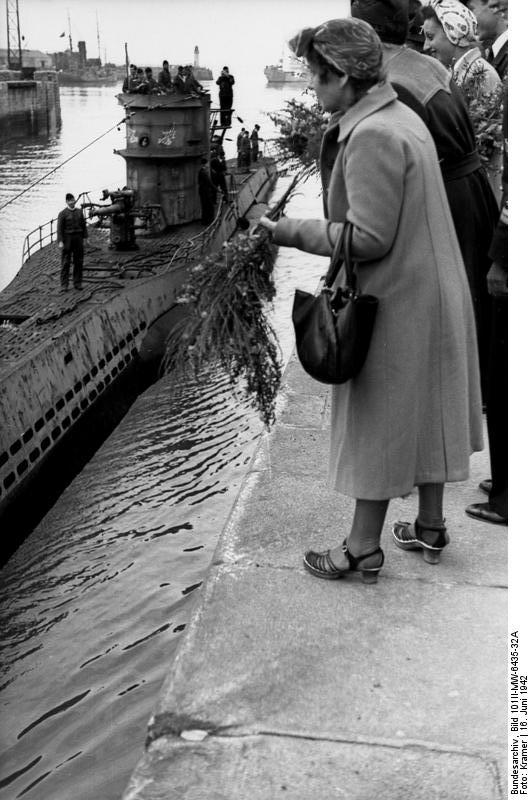
The base and its two flotillas reached their peak of activity in July, August and September 1943. Between September 1940 and May 1945 their U-boats undertook 403 patrols, the third highest of any U-boat base in Germany or overseas. U-Boat aces stationed here (mostly from the 7th Flotilla) included U-48 Schultze/Bleichrodt (13 patrols, 51 ships sunk); U-96 Lehmann-Willenbrock (11 patrols, 27 ships sunk); U-552 Topp (15 patrols, 30 ships sunk).
The city and port facilities of Saint-Nazaire were leveled in over 50 allied air raids during the war, during which the bunker was bombed 13 times with over 44,000 pounds of bombs. Despite this, the bunker suffered no significant damage and remained operational throughout the war.
The last U-boat to set out on patrol from Saint-Nazaire was the U-255 on 8 May 1945. Four days later she surrendered at sea.
Saint-Nazaire itself became a German fortress – a pocket of resistance to the Advancing Allied forces. It held out for nine months – although by September 1944 the allies had decided not to bother attacking it*** – until 8 May 1945 when the German commander, General Junck, agreed to surrender. He handed over his weapon to US General Kramer of the 66th Infantry division on 11 May 1945.
When US soldiers entered the base they found U-510, a type IXC U-boat which had arrived from the Far East on the 23 April 1945. She was commissioned into the French Navy as S-11 Bouan in 1946 and remained operational until 1963.
Saint-Nazaire Submarine Base Now
After WW2 the base was occasionally used by the French Navy and commercial maritime companies, but it was mostly left derelict till 1994 when the city council decided to make better use of it. Project ‘Ville-Port’ opened up the back wall to pens 8-11, and used the pens for an experiential museum, exhibition space, and a music venue. They also built a long ramp up to give the public access to the roof.

Pen 09, Tourist Office (Swipe left or click arrow for more…)
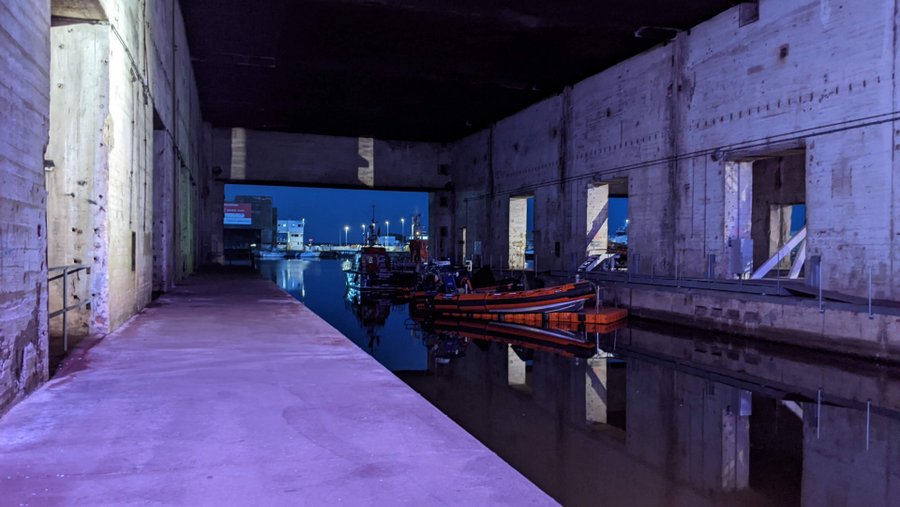
SNSM (French lifeboat service) Rigid Inflatable Boats (RIBs) in Pen 9
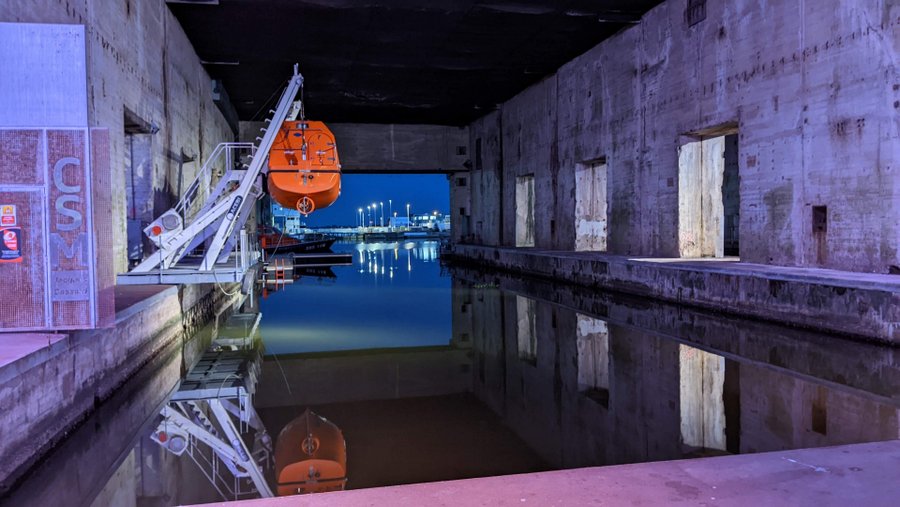
There are 14 pens & 3 sections (stairwells). Their uses now are…
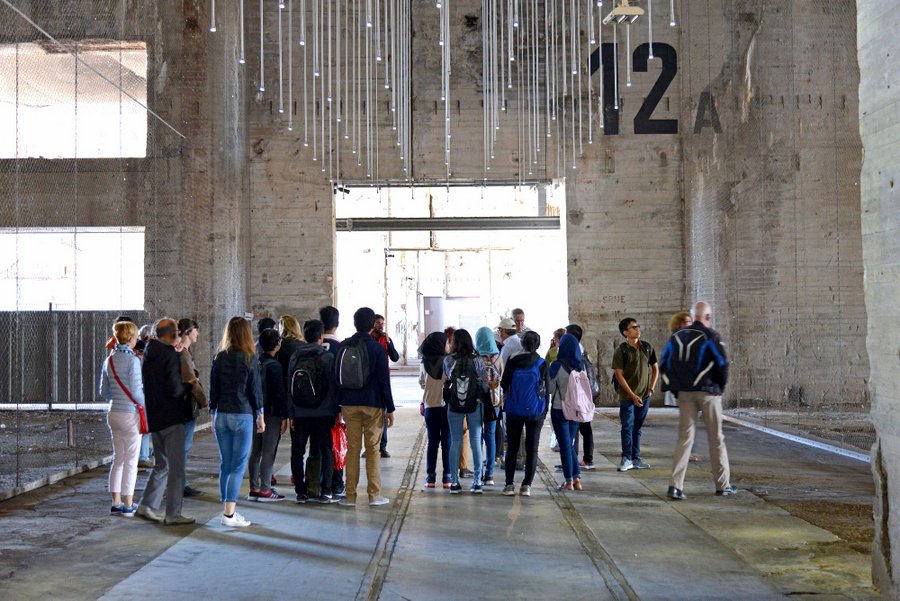
Saint-Nazaire Tourism operate 75-minute tours (in French) of the submarine base, covering pens 7 – 12 and the rooftop. Prices in the factbox below.
* The Lorient U-boat base comprised three bunkers, “Keroman I”, “II” and “III”; the “Scorff” bunker (on the river Scorff); and two “Dom” (cathedral) bunkers, east and west.
** The crews were billeted in La Baule a few miles away on the coast for some fresh air and R&R. Sometimes if repairs to their boat would take a month or more, they were given leave in Germany.
*** The Germans fortified all their Atlantic ports, hoping that if the Allies lost their remaining artificial port, Mulberry B, in Normandy they would be cut of from their supplies and the Germans could counter-attack. However, Cherbourg was captured quickly and then in mid-September 1944 Brest is taken. Meanwhile as they advance north, the Allies capture Le Havre, Dieppe & Boulogne. So, attacking the heavily fortified ports of Lorient and Saint-Nazaire is no longer important to Allied strategy and simply not worth it.
**** Sunk by a mine on 5 April 1944 in the Mediterranean, south-east of Genoa. All hands lost.
¹ Wikipedia
Declaration: I was on a self-driving press trip as a guest of the Saint-Nazaire tourist office.
Website : Saint-Nazaire City Tours (inc Submarine base)
Getting there : Escal’Atlantic, Submarine base, Boulevard de la Légion d’Honneur, Saint-Nazaire, France.
The meeting point for the tour is at the Tourist Office in Pen 09
Tour Price (2023) :
Times (2023) :
Tours are on Sundays only at 17.00 from now to 25 June.
From 10 July – 27 Aug the tours are daily at 11.30am & 17.00pm
Related Stories
You may like this, review: d-day omaha museum, vierville.
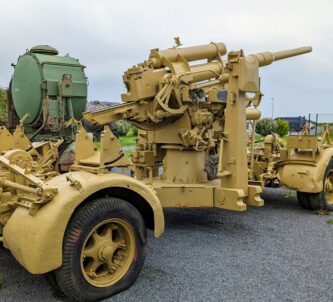
New ‘Jolly Roger’ display at the Submarine Museum, Gosport

Review: Normandy Victory Museum
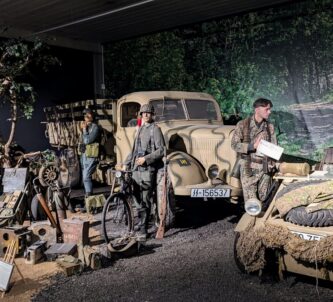
New Photo Exhibition of Underground Stations being used as Bomb Shelters – Then and Now

Bawdsey Radar Museum
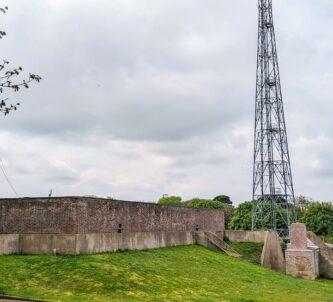
Join the Conversation →
Leave a reply cancel reply.
Your email address will not be published. Required fields are marked *
This site uses Akismet to reduce spam. Learn how your comment data is processed .
This is a niche blog about technically-minded travel. It reflects my own interests in the mechanical, technical, historical, engineering, transport and military world.
COPYRIGHT © MECHTRAVELLER 2016-2024, including all images unless indicated otherwise.
- Saint Nazaire Church
- Prepare your stay
Accessibility
- The adapted structures
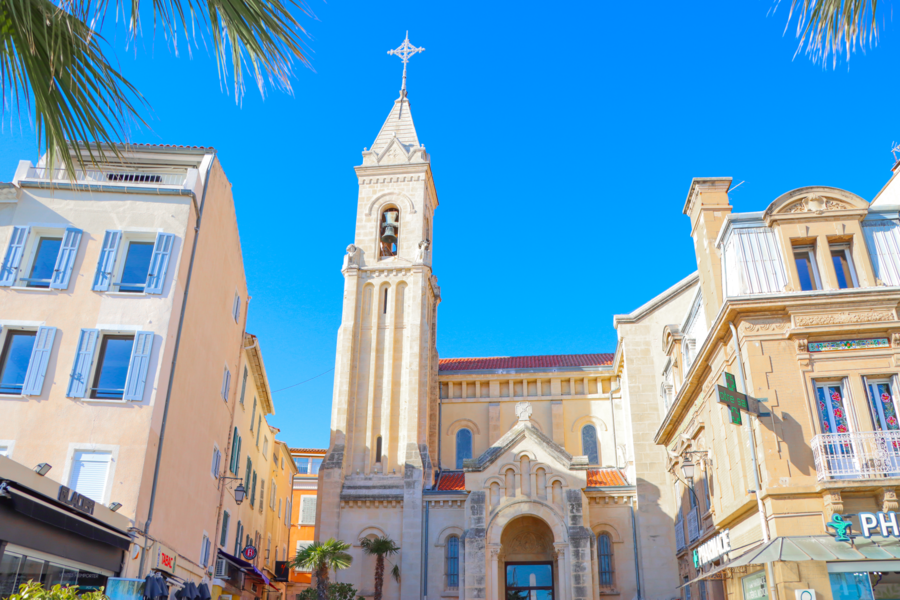
In 1570, faced with the increase in population, the inhabitants of Sanary decided to build their church on the site of the priory of the monks of Saint Victor and dedicated it to Saint Nazaire.
Until then, the hamlet of Saint-Nazaire depended on the parish. From 1570, the first parish registers were opened. It was the beginning of a true independent religious life crowned by the arrival, and in a grand ceremony, of the relics of Saint Nazaire on 26 July 1650. At the end of the 19th century Marius Michel dit Michel Pacha, former mayor, decided to offer his hometown a new church. It was built on the plans of architect Paul Page on the site of the previous one, which generated a certain amount of opposition. The church was blessed on July 31, 1892. The organ of the old church, a Charles Gazeau from the 19th century, probably disappeared during the demolition. In the new church, Mader installed and enlarged a small John Abbey organ offered by Camille Saint-Saëns to Michel Pacha. A century later, the state of the instrument led the city, with the support of the Ministry of Culture, to commission the construction of a new organ installed in 2009. The choice is a 30-stop organ with exceptional acoustic qualities offering a wide musical range by adopting the principle of resonance.
Environment
- Close to pleasure port
- In centre of town
- Town location
- Accessible for wheelchairs with assistance
- Themed tour
Place Michel Pacha
83110 Sanary-sur-Mer
Discover also
The organ of sanary-sur-mer, the frescoes of light, christmas eve & midnight mass.

COMMENTS
In Saint-Nazaire, each time a vessel leaves the shipyard, a spectacular open-air show takes place in the Loire Estuary to the delight of locals and visitors alike. Enough to... Our Greeter walks. We invite you to discover Saint-Nazaire and the Brière Marshes from another perspective, that of a local who's passionate about the area.
Bienvenue sur le site officiel de Saint-Nazaire Renversante. Retrouvez les informations pour préparer votre séjour et réserver vos visites des sites ... Destination Cote Atlantique Office Tourisme Saint Nazaire Bd 188. Savourer. Le Sammy est une statue située sur le front de mer de Saint-Nazaire au niveau de la grande plage. Préparer votre ...
Getting to Saint-Nazaire. There are direct flights from Gatwick and Stansted to Nantes-Atlantique Airport, located about 60 km from Saint-Nazaire, with transport from the airport on the TER regional transport network or by bus.By train, Eurostar takes 2 hours and 16 minutes from London to Paris, then there are 13 TGV intercity services each day from Paris-Montparnasse to Saint-Nazaire, taking ...
Office de Tourisme de Saint-Nazaire et Brière : Tél : 02 40 22 40 65. E-mail : [email protected]. Retrouvez l'équipe de l'Office de tourisme de Saint-Nazaire et de la Brière lors de déplacements ponctuels sur les marchés, aux abords des plages et à l'occasion d'événements organisés sur le territoire !
Our Tourist Information Office for Saint-Nazaire and its surroundings is located in: Saint-Nazaire, Submarine base, bd de la Légion d'Honneur, +332 40 22 40 65, [email protected].
Saint-Nazaire Tourisme & Patrimoine / Visit Saint-Nazaire Office de Tourisme Base sous-marine, Boulevard de la Légion d'Honneur, Ville-Port 44600 Saint-Nazaire Phone: 00 33 240 224 065 (External link) Information about the tourist sites : phone 00 33 228 540 640.
Mainly focused on the sea and the naval industry, tourism in Saint-Nazaire is an opportunity to admire incredible sites, starting with Escal'Atlantic. In the old submarine base of more than 3,700 m², this liner museum is entirely devoted to the era of the great transatlantic liners built in Saint-Nazaire. ... Tourist Office of Saint-Nazaire ...
Homepage - Stunning Saint-Nazaire. Plan My Stay. Things To Do. Strolls and hikes, flat-bottomed boat rides, water activities, museums, attractions…. Whether on a day trip or an extended stay, you'll find plenty of things to do in Saint-Nazaire and the Brière Regional Natural Park!
Vélocéan: Vélocéan is a cycle route on the Atlantic coast in the Loire-Atlantique department, and therefore serving Saint-Nazaire. Get around [edit] A free electric shuttle connects the theater car park (free parking) to the city center in a few minutes, passing through the Tourist Office and the city's flagship tourist facility "Escal ...
The Intercommunal Tourist Office is your privileged contact to prepare your stay in Saint-Nazaire and Brière. You will find all the information on events,…
Here are our top ten reasons to explore the beaches, parks, hikes, and ships of the town - there's even a submarine to discover. 1. Saint-Nazaire's beautiful seafront: the perfect place to relax. Sit on one of the many seafront terraces at Place du Commando and sip a lemonade (or something stronger) while watching the tide come in or head ...
1. Escal'Atlantic. 1,018. Speciality Museums. Inside the former submarine base in the harbour of Saint-Nazaire, a hidden treasure lies in store for you. Escal'Atlantic, the ocean liner experience, is a unique interactive visit for the whole family.
Meeting point: submarine base, near the Tourist Office; Make savings thanks to the 'PASS Patrimoine': Écomusée + 1 guided tour "La base sous-marine, histoire d'une reconquête" ... Guided Tour: "Un tour de Saint-Nazaire en 90 minutes" (90-minute city tour of Saint-Nazaire)
Discover The Port. The submarine base of Saint-Nazaire. The former submarine base, built by the Germans in WW2, has become an integral part of our landscape. After extensive redevelopment, the base is now a unique cultural and tourism site. Explore its depths then climb to the roof to see your surroundings from a fresh perspective!
Up to 4 people can even stay in one overnight in Saint Malo de Guersdac. Check with the tourist office. Les Pêcheries. If you have a car, drive over the spectacular St. Nazaire Bridge to Saint-Brevin-les-Pins on the opposite bank of the Loire (take the first exit after the bridge).
Visiting Saint-Nazaire: 10 must-do activities. Walking around the port. Visit the ecomuseum to learn about the town's history. Embark on Escal'Atlantic: the interactive museum. Take on the role of a sailor and visit the submarine Espadon. Visit the Airbus and Chantiers de l'Atlantique industrial sites. Hunting for street art.
Saint-Nazaire Tourist Office Brittany Tourist Office Atlantique-Loire Valley Tourist Office. How to get to Saint-Nazaire. Saint-Nazaire is in Brittany, in the Loire-Atlantique region. By car: The nearest ferry port from the UK is St-Malo used by Brittany Ferries. It's around 200 kms/124 miles and takes around 2 hrs 30 mins.
An impressive belvedere with views of the Dordogne and Diège gorges, the famous site of Saint-Nazaire, in Corrèze, is located 12 kilometres to the west of Bort-les-Orgues, in the municipality of Saint-Julien-près-Bort.. Nestling amid the greenery, this remarkable place is named after a legend: St. Nazarius is said to have driven the devil from the place.
Brittany Ferries operates daily overnight sailings from Portsmouth to St Malo, with daytime return sailings from St Malo to Portsmouth. Book online at brittany-ferries.co.uk or call 0330 159 7000.
So, attacking the heavily fortified ports of Lorient and Saint-Nazaire is no longer important to Allied strategy and simply not worth it. **** Sunk by a mine on 5 April 1944 in the Mediterranean, south-east of Genoa. All hands lost. ¹ Wikipedia. Declaration: I was on a self-driving press trip as a guest of the Saint-Nazaire tourist office.
Until then, the hamlet of Saint-Nazaire depended on the parish. From 1570, the first parish registers were opened. It was the beginning of a true independent religious life crowned by the arrival, and in a grand ceremony, of the relics of Saint Nazaire on 26 July 1650. ... ©Sanary Tourist Office, 2024 - The adapted structures - ...